Differences between Organizations for Profit, Non-Profit and Non-Government Companies
VerifiedAdded on 2023/01/13
|23
|6935
|80
AI Summary
This study explains the differences between organizations for profit, non-profit, and non-government companies. It also discusses the differences between micro, small, and medium-sized enterprises and the range of legal structures associated with different forms of businesses.
Contribute Materials
Your contribution can guide someone’s learning journey. Share your
documents today.
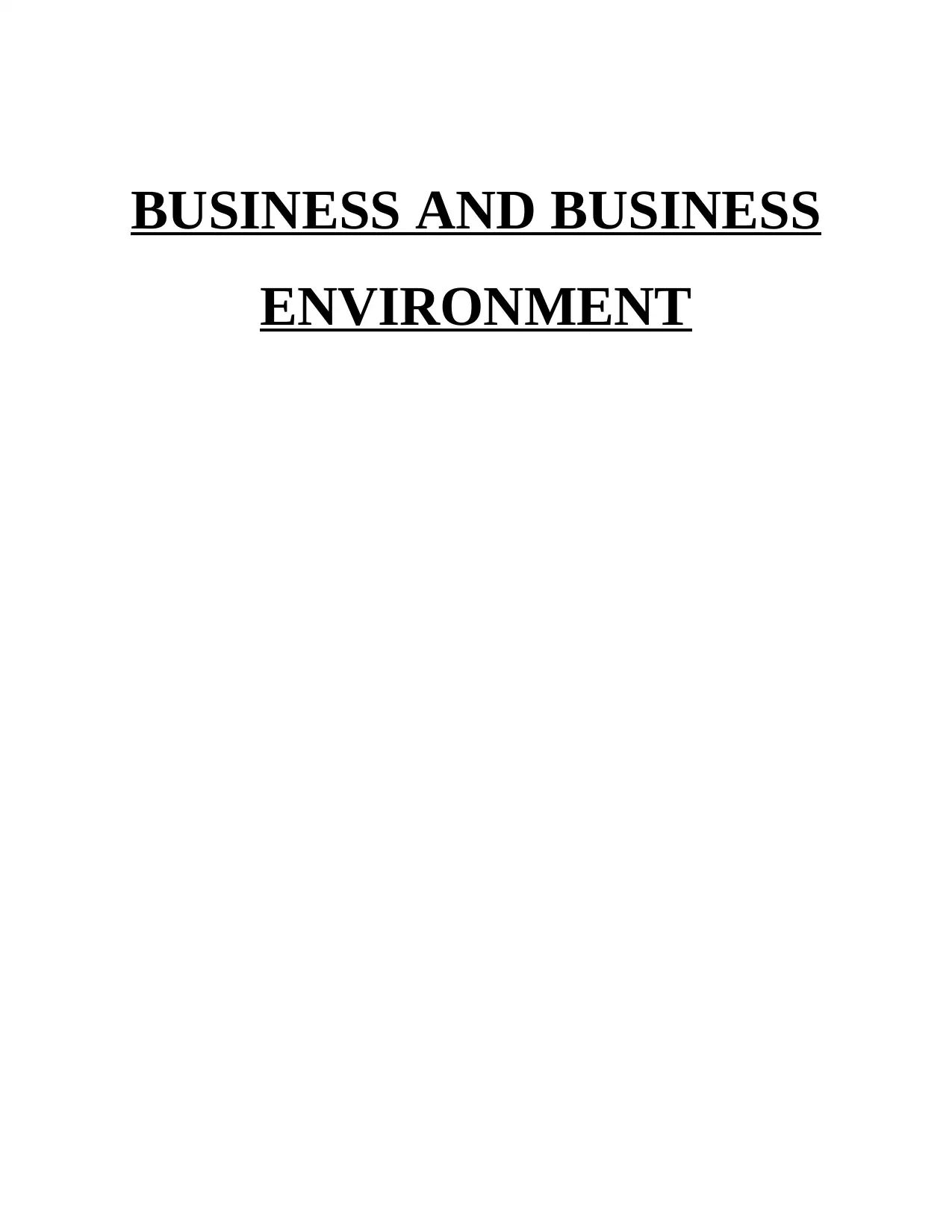
BUSINESS AND BUSINESS
ENVIRONMENT
ENVIRONMENT
Secure Best Marks with AI Grader
Need help grading? Try our AI Grader for instant feedback on your assignments.
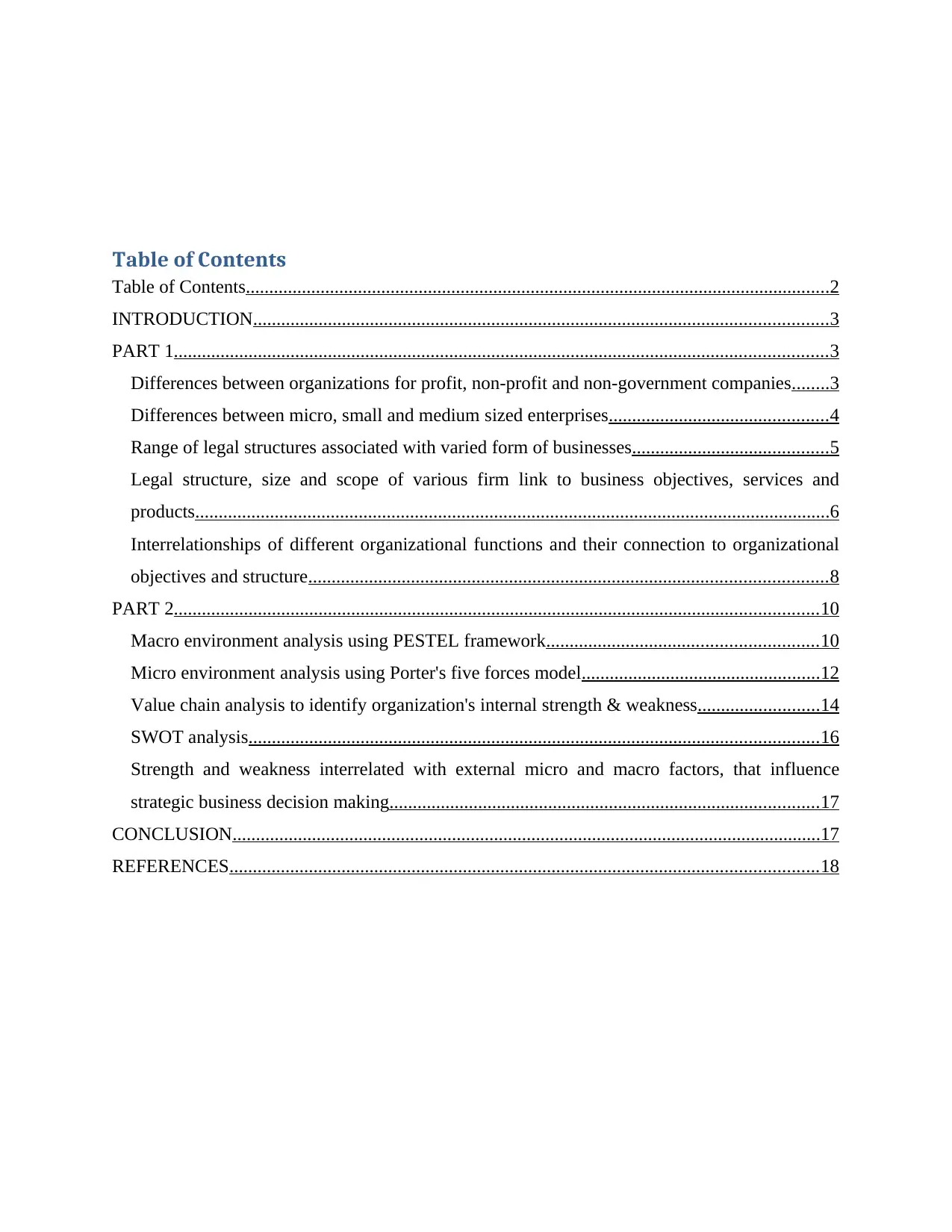
Table of Contents
Table of Contents.............................................................................................................................2
INTRODUCTION...........................................................................................................................3
PART 1............................................................................................................................................3
Differences between organizations for profit, non-profit and non-government companies........3
Differences between micro, small and medium sized enterprises...............................................4
Range of legal structures associated with varied form of businesses..........................................5
Legal structure, size and scope of various firm link to business objectives, services and
products........................................................................................................................................6
Interrelationships of different organizational functions and their connection to organizational
objectives and structure...............................................................................................................8
PART 2..........................................................................................................................................10
Macro environment analysis using PESTEL framework..........................................................10
Micro environment analysis using Porter's five forces model...................................................12
Value chain analysis to identify organization's internal strength & weakness..........................14
SWOT analysis..........................................................................................................................16
Strength and weakness interrelated with external micro and macro factors, that influence
strategic business decision making............................................................................................17
CONCLUSION..............................................................................................................................17
REFERENCES..............................................................................................................................18
Table of Contents.............................................................................................................................2
INTRODUCTION...........................................................................................................................3
PART 1............................................................................................................................................3
Differences between organizations for profit, non-profit and non-government companies........3
Differences between micro, small and medium sized enterprises...............................................4
Range of legal structures associated with varied form of businesses..........................................5
Legal structure, size and scope of various firm link to business objectives, services and
products........................................................................................................................................6
Interrelationships of different organizational functions and their connection to organizational
objectives and structure...............................................................................................................8
PART 2..........................................................................................................................................10
Macro environment analysis using PESTEL framework..........................................................10
Micro environment analysis using Porter's five forces model...................................................12
Value chain analysis to identify organization's internal strength & weakness..........................14
SWOT analysis..........................................................................................................................16
Strength and weakness interrelated with external micro and macro factors, that influence
strategic business decision making............................................................................................17
CONCLUSION..............................................................................................................................17
REFERENCES..............................................................................................................................18

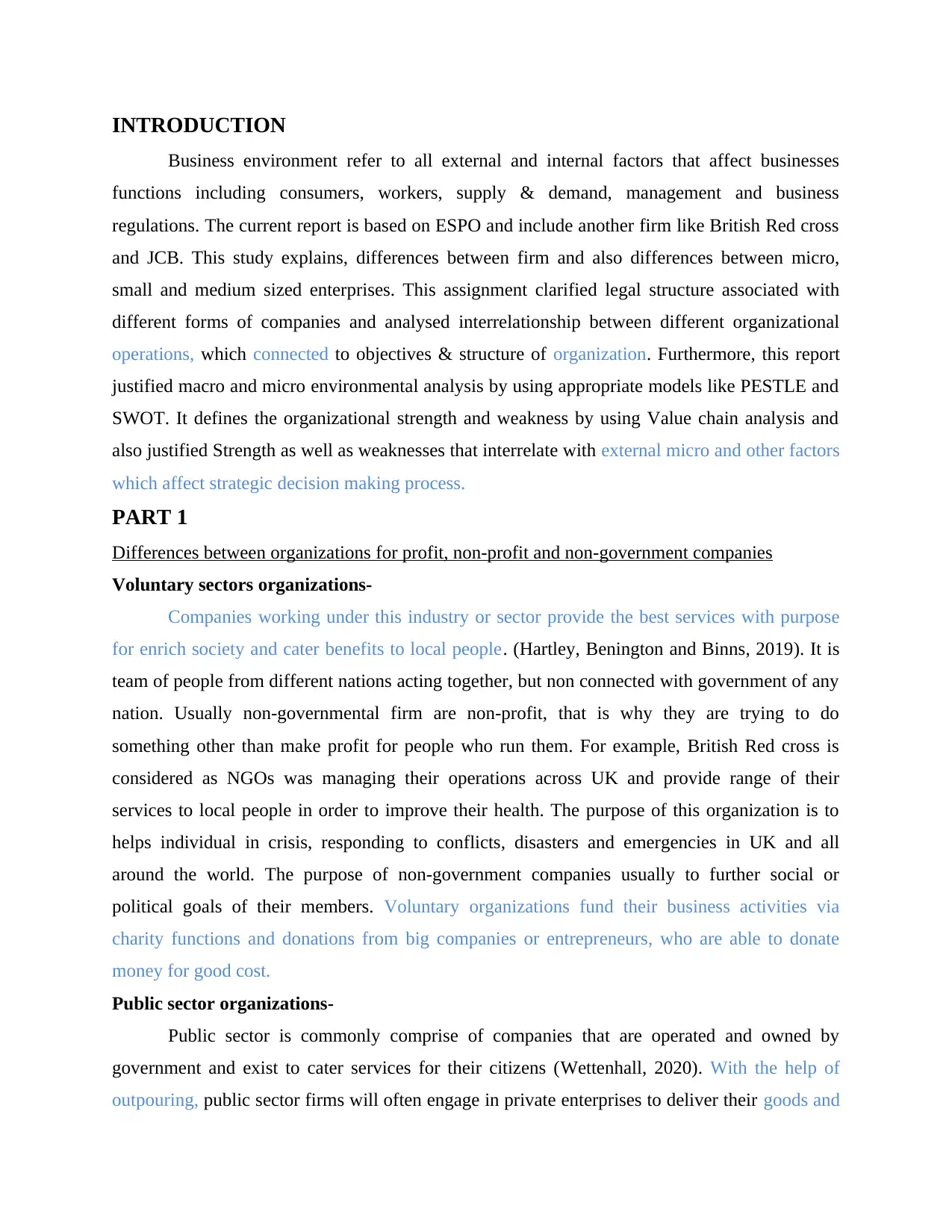
INTRODUCTION
Business environment refer to all external and internal factors that affect businesses
functions including consumers, workers, supply & demand, management and business
regulations. The current report is based on ESPO and include another firm like British Red cross
and JCB. This study explains, differences between firm and also differences between micro,
small and medium sized enterprises. This assignment clarified legal structure associated with
different forms of companies and analysed interrelationship between different organizational
operations, which connected to objectives & structure of organization. Furthermore, this report
justified macro and micro environmental analysis by using appropriate models like PESTLE and
SWOT. It defines the organizational strength and weakness by using Value chain analysis and
also justified Strength as well as weaknesses that interrelate with external micro and other factors
which affect strategic decision making process.
PART 1
Differences between organizations for profit, non-profit and non-government companies
Voluntary sectors organizations-
Companies working under this industry or sector provide the best services with purpose
for enrich society and cater benefits to local people. (Hartley, Benington and Binns, 2019). It is
team of people from different nations acting together, but non connected with government of any
nation. Usually non-governmental firm are non-profit, that is why they are trying to do
something other than make profit for people who run them. For example, British Red cross is
considered as NGOs was managing their operations across UK and provide range of their
services to local people in order to improve their health. The purpose of this organization is to
helps individual in crisis, responding to conflicts, disasters and emergencies in UK and all
around the world. The purpose of non-government companies usually to further social or
political goals of their members. Voluntary organizations fund their business activities via
charity functions and donations from big companies or entrepreneurs, who are able to donate
money for good cost.
Public sector organizations-
Public sector is commonly comprise of companies that are operated and owned by
government and exist to cater services for their citizens (Wettenhall, 2020). With the help of
outpouring, public sector firms will often engage in private enterprises to deliver their goods and
Business environment refer to all external and internal factors that affect businesses
functions including consumers, workers, supply & demand, management and business
regulations. The current report is based on ESPO and include another firm like British Red cross
and JCB. This study explains, differences between firm and also differences between micro,
small and medium sized enterprises. This assignment clarified legal structure associated with
different forms of companies and analysed interrelationship between different organizational
operations, which connected to objectives & structure of organization. Furthermore, this report
justified macro and micro environmental analysis by using appropriate models like PESTLE and
SWOT. It defines the organizational strength and weakness by using Value chain analysis and
also justified Strength as well as weaknesses that interrelate with external micro and other factors
which affect strategic decision making process.
PART 1
Differences between organizations for profit, non-profit and non-government companies
Voluntary sectors organizations-
Companies working under this industry or sector provide the best services with purpose
for enrich society and cater benefits to local people. (Hartley, Benington and Binns, 2019). It is
team of people from different nations acting together, but non connected with government of any
nation. Usually non-governmental firm are non-profit, that is why they are trying to do
something other than make profit for people who run them. For example, British Red cross is
considered as NGOs was managing their operations across UK and provide range of their
services to local people in order to improve their health. The purpose of this organization is to
helps individual in crisis, responding to conflicts, disasters and emergencies in UK and all
around the world. The purpose of non-government companies usually to further social or
political goals of their members. Voluntary organizations fund their business activities via
charity functions and donations from big companies or entrepreneurs, who are able to donate
money for good cost.
Public sector organizations-
Public sector is commonly comprise of companies that are operated and owned by
government and exist to cater services for their citizens (Wettenhall, 2020). With the help of
outpouring, public sector firms will often engage in private enterprises to deliver their goods and
Secure Best Marks with AI Grader
Need help grading? Try our AI Grader for instant feedback on your assignments.
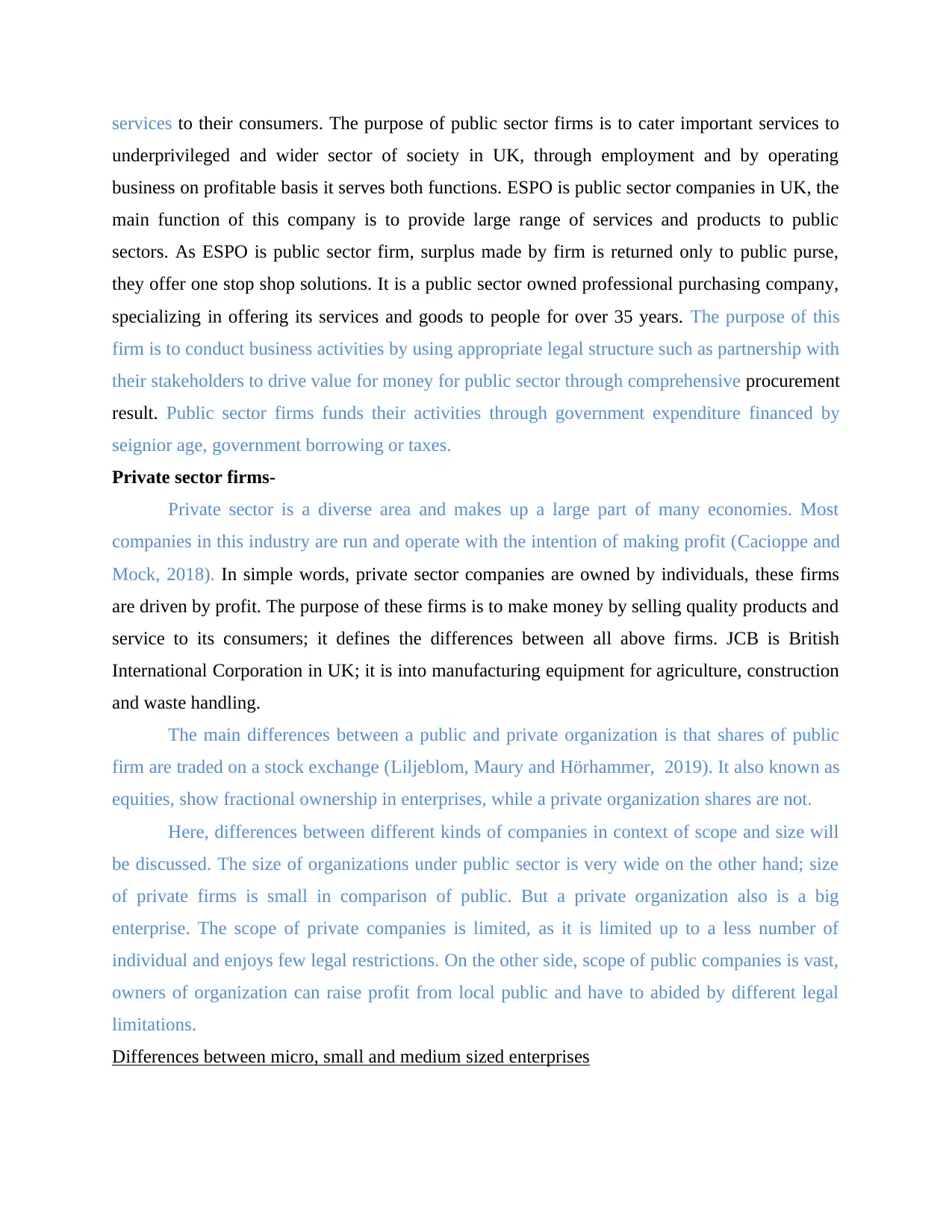
services to their consumers. The purpose of public sector firms is to cater important services to
underprivileged and wider sector of society in UK, through employment and by operating
business on profitable basis it serves both functions. ESPO is public sector companies in UK, the
main function of this company is to provide large range of services and products to public
sectors. As ESPO is public sector firm, surplus made by firm is returned only to public purse,
they offer one stop shop solutions. It is a public sector owned professional purchasing company,
specializing in offering its services and goods to people for over 35 years. The purpose of this
firm is to conduct business activities by using appropriate legal structure such as partnership with
their stakeholders to drive value for money for public sector through comprehensive procurement
result. Public sector firms funds their activities through government expenditure financed by
seignior age, government borrowing or taxes.
Private sector firms-
Private sector is a diverse area and makes up a large part of many economies. Most
companies in this industry are run and operate with the intention of making profit (Cacioppe and
Mock, 2018). In simple words, private sector companies are owned by individuals, these firms
are driven by profit. The purpose of these firms is to make money by selling quality products and
service to its consumers; it defines the differences between all above firms. JCB is British
International Corporation in UK; it is into manufacturing equipment for agriculture, construction
and waste handling.
The main differences between a public and private organization is that shares of public
firm are traded on a stock exchange (Liljeblom, Maury and Hörhammer, 2019). It also known as
equities, show fractional ownership in enterprises, while a private organization shares are not.
Here, differences between different kinds of companies in context of scope and size will
be discussed. The size of organizations under public sector is very wide on the other hand; size
of private firms is small in comparison of public. But a private organization also is a big
enterprise. The scope of private companies is limited, as it is limited up to a less number of
individual and enjoys few legal restrictions. On the other side, scope of public companies is vast,
owners of organization can raise profit from local public and have to abided by different legal
limitations.
Differences between micro, small and medium sized enterprises
underprivileged and wider sector of society in UK, through employment and by operating
business on profitable basis it serves both functions. ESPO is public sector companies in UK, the
main function of this company is to provide large range of services and products to public
sectors. As ESPO is public sector firm, surplus made by firm is returned only to public purse,
they offer one stop shop solutions. It is a public sector owned professional purchasing company,
specializing in offering its services and goods to people for over 35 years. The purpose of this
firm is to conduct business activities by using appropriate legal structure such as partnership with
their stakeholders to drive value for money for public sector through comprehensive procurement
result. Public sector firms funds their activities through government expenditure financed by
seignior age, government borrowing or taxes.
Private sector firms-
Private sector is a diverse area and makes up a large part of many economies. Most
companies in this industry are run and operate with the intention of making profit (Cacioppe and
Mock, 2018). In simple words, private sector companies are owned by individuals, these firms
are driven by profit. The purpose of these firms is to make money by selling quality products and
service to its consumers; it defines the differences between all above firms. JCB is British
International Corporation in UK; it is into manufacturing equipment for agriculture, construction
and waste handling.
The main differences between a public and private organization is that shares of public
firm are traded on a stock exchange (Liljeblom, Maury and Hörhammer, 2019). It also known as
equities, show fractional ownership in enterprises, while a private organization shares are not.
Here, differences between different kinds of companies in context of scope and size will
be discussed. The size of organizations under public sector is very wide on the other hand; size
of private firms is small in comparison of public. But a private organization also is a big
enterprise. The scope of private companies is limited, as it is limited up to a less number of
individual and enjoys few legal restrictions. On the other side, scope of public companies is vast,
owners of organization can raise profit from local public and have to abided by different legal
limitations.
Differences between micro, small and medium sized enterprises
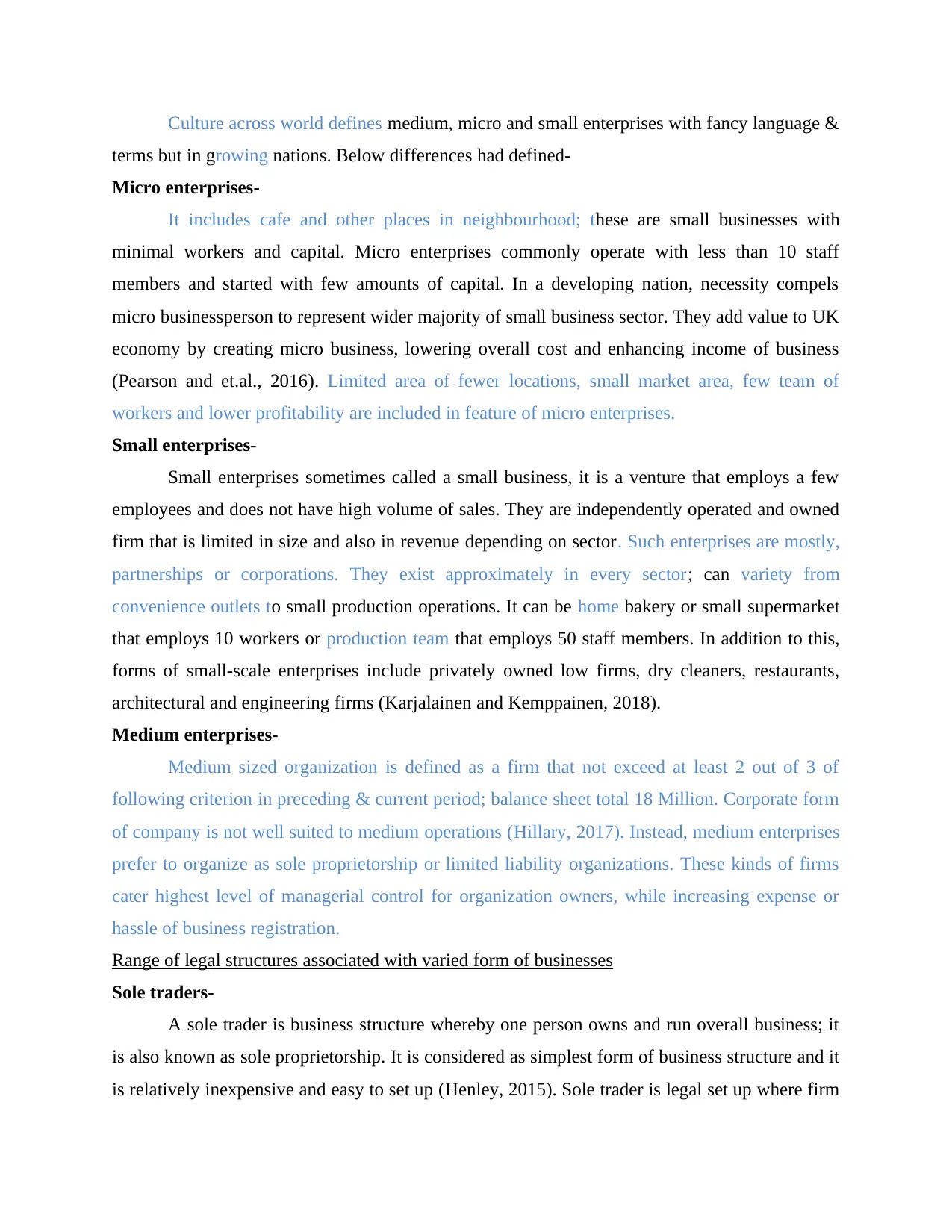
Culture across world defines medium, micro and small enterprises with fancy language &
terms but in growing nations. Below differences had defined-
Micro enterprises-
It includes cafe and other places in neighbourhood; these are small businesses with
minimal workers and capital. Micro enterprises commonly operate with less than 10 staff
members and started with few amounts of capital. In a developing nation, necessity compels
micro businessperson to represent wider majority of small business sector. They add value to UK
economy by creating micro business, lowering overall cost and enhancing income of business
(Pearson and et.al., 2016). Limited area of fewer locations, small market area, few team of
workers and lower profitability are included in feature of micro enterprises.
Small enterprises-
Small enterprises sometimes called a small business, it is a venture that employs a few
employees and does not have high volume of sales. They are independently operated and owned
firm that is limited in size and also in revenue depending on sector. Such enterprises are mostly,
partnerships or corporations. They exist approximately in every sector; can variety from
convenience outlets to small production operations. It can be home bakery or small supermarket
that employs 10 workers or production team that employs 50 staff members. In addition to this,
forms of small-scale enterprises include privately owned low firms, dry cleaners, restaurants,
architectural and engineering firms (Karjalainen and Kemppainen, 2018).
Medium enterprises-
Medium sized organization is defined as a firm that not exceed at least 2 out of 3 of
following criterion in preceding & current period; balance sheet total 18 Million. Corporate form
of company is not well suited to medium operations (Hillary, 2017). Instead, medium enterprises
prefer to organize as sole proprietorship or limited liability organizations. These kinds of firms
cater highest level of managerial control for organization owners, while increasing expense or
hassle of business registration.
Range of legal structures associated with varied form of businesses
Sole traders-
A sole trader is business structure whereby one person owns and run overall business; it
is also known as sole proprietorship. It is considered as simplest form of business structure and it
is relatively inexpensive and easy to set up (Henley, 2015). Sole trader is legal set up where firm
terms but in growing nations. Below differences had defined-
Micro enterprises-
It includes cafe and other places in neighbourhood; these are small businesses with
minimal workers and capital. Micro enterprises commonly operate with less than 10 staff
members and started with few amounts of capital. In a developing nation, necessity compels
micro businessperson to represent wider majority of small business sector. They add value to UK
economy by creating micro business, lowering overall cost and enhancing income of business
(Pearson and et.al., 2016). Limited area of fewer locations, small market area, few team of
workers and lower profitability are included in feature of micro enterprises.
Small enterprises-
Small enterprises sometimes called a small business, it is a venture that employs a few
employees and does not have high volume of sales. They are independently operated and owned
firm that is limited in size and also in revenue depending on sector. Such enterprises are mostly,
partnerships or corporations. They exist approximately in every sector; can variety from
convenience outlets to small production operations. It can be home bakery or small supermarket
that employs 10 workers or production team that employs 50 staff members. In addition to this,
forms of small-scale enterprises include privately owned low firms, dry cleaners, restaurants,
architectural and engineering firms (Karjalainen and Kemppainen, 2018).
Medium enterprises-
Medium sized organization is defined as a firm that not exceed at least 2 out of 3 of
following criterion in preceding & current period; balance sheet total 18 Million. Corporate form
of company is not well suited to medium operations (Hillary, 2017). Instead, medium enterprises
prefer to organize as sole proprietorship or limited liability organizations. These kinds of firms
cater highest level of managerial control for organization owners, while increasing expense or
hassle of business registration.
Range of legal structures associated with varied form of businesses
Sole traders-
A sole trader is business structure whereby one person owns and run overall business; it
is also known as sole proprietorship. It is considered as simplest form of business structure and it
is relatively inexpensive and easy to set up (Henley, 2015). Sole trader is legal set up where firm
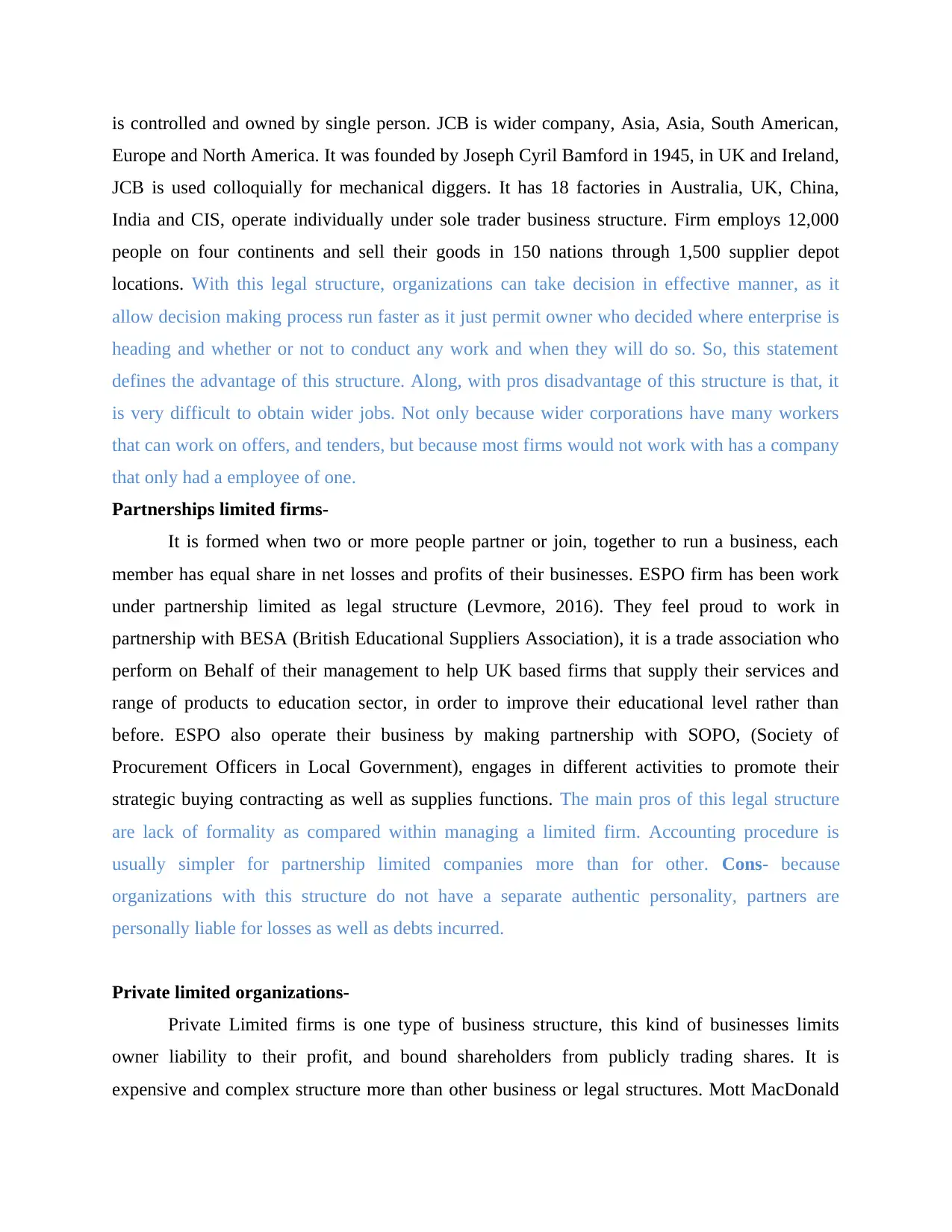
is controlled and owned by single person. JCB is wider company, Asia, Asia, South American,
Europe and North America. It was founded by Joseph Cyril Bamford in 1945, in UK and Ireland,
JCB is used colloquially for mechanical diggers. It has 18 factories in Australia, UK, China,
India and CIS, operate individually under sole trader business structure. Firm employs 12,000
people on four continents and sell their goods in 150 nations through 1,500 supplier depot
locations. With this legal structure, organizations can take decision in effective manner, as it
allow decision making process run faster as it just permit owner who decided where enterprise is
heading and whether or not to conduct any work and when they will do so. So, this statement
defines the advantage of this structure. Along, with pros disadvantage of this structure is that, it
is very difficult to obtain wider jobs. Not only because wider corporations have many workers
that can work on offers, and tenders, but because most firms would not work with has a company
that only had a employee of one.
Partnerships limited firms-
It is formed when two or more people partner or join, together to run a business, each
member has equal share in net losses and profits of their businesses. ESPO firm has been work
under partnership limited as legal structure (Levmore, 2016). They feel proud to work in
partnership with BESA (British Educational Suppliers Association), it is a trade association who
perform on Behalf of their management to help UK based firms that supply their services and
range of products to education sector, in order to improve their educational level rather than
before. ESPO also operate their business by making partnership with SOPO, (Society of
Procurement Officers in Local Government), engages in different activities to promote their
strategic buying contracting as well as supplies functions. The main pros of this legal structure
are lack of formality as compared within managing a limited firm. Accounting procedure is
usually simpler for partnership limited companies more than for other. Cons- because
organizations with this structure do not have a separate authentic personality, partners are
personally liable for losses as well as debts incurred.
Private limited organizations-
Private Limited firms is one type of business structure, this kind of businesses limits
owner liability to their profit, and bound shareholders from publicly trading shares. It is
expensive and complex structure more than other business or legal structures. Mott MacDonald
Europe and North America. It was founded by Joseph Cyril Bamford in 1945, in UK and Ireland,
JCB is used colloquially for mechanical diggers. It has 18 factories in Australia, UK, China,
India and CIS, operate individually under sole trader business structure. Firm employs 12,000
people on four continents and sell their goods in 150 nations through 1,500 supplier depot
locations. With this legal structure, organizations can take decision in effective manner, as it
allow decision making process run faster as it just permit owner who decided where enterprise is
heading and whether or not to conduct any work and when they will do so. So, this statement
defines the advantage of this structure. Along, with pros disadvantage of this structure is that, it
is very difficult to obtain wider jobs. Not only because wider corporations have many workers
that can work on offers, and tenders, but because most firms would not work with has a company
that only had a employee of one.
Partnerships limited firms-
It is formed when two or more people partner or join, together to run a business, each
member has equal share in net losses and profits of their businesses. ESPO firm has been work
under partnership limited as legal structure (Levmore, 2016). They feel proud to work in
partnership with BESA (British Educational Suppliers Association), it is a trade association who
perform on Behalf of their management to help UK based firms that supply their services and
range of products to education sector, in order to improve their educational level rather than
before. ESPO also operate their business by making partnership with SOPO, (Society of
Procurement Officers in Local Government), engages in different activities to promote their
strategic buying contracting as well as supplies functions. The main pros of this legal structure
are lack of formality as compared within managing a limited firm. Accounting procedure is
usually simpler for partnership limited companies more than for other. Cons- because
organizations with this structure do not have a separate authentic personality, partners are
personally liable for losses as well as debts incurred.
Private limited organizations-
Private Limited firms is one type of business structure, this kind of businesses limits
owner liability to their profit, and bound shareholders from publicly trading shares. It is
expensive and complex structure more than other business or legal structures. Mott MacDonald
Paraphrase This Document
Need a fresh take? Get an instant paraphrase of this document with our AI Paraphraser

group is private limited organization, it is consultancy with Headquarter in UK. Firm employs
more than 16,00 staff in 150 nations, it was considered as one of the biggest employees owned
organizations in the world (Alvesson, 2019). Pro- it is well known that a private limited firm is
more likely to be tax efficient as compared to sole trade or other legal structure. Con- sole trader
is straightforward and very easy to run as it only has to register with HMRC. Whereas, comply
with or setting up this structure will mean registering with organizations house.
Public limited companies-
The feature of public limited firm is limited liability and perpetual succession. Raising
capital through public issue of shares is the advantage of this structure. In simple words, being a
public limited organization is capability to increase share capital, especially where firm is lited
on a documented exchange. Disadvantage- to aid protects shareholders, regulatory and legal
requirements for public limited firms are more onerous rather than for private limited
organizations.
Legal structure, size and scope of various firm link to business objectives, services and products
JCB-
JCB was established in 1954 and number of people in firm are approximately 11000. In
context of their size by revenue, company estimated their revenue of 2017 was 3.35 Billion.
They are able to supply mostly those goods which is used in house building sector, specially
linked with construction. The mission of JCB firm is to become the top producing and
manufacturing firm to cater the highest quality services to its consumers. The objectives, services
and products of this company is linked with legal structure, size and scope as number of
employee are able to service the best service to its consumers, they help to achieve business
objective and increase profit as well as generate revenue through effective work performance
that also help to increase productivity of business rather than before. With the help of choosing
right legal structure, organization will utilize its features in order to achieve aims and set
objectives.
Range of employees in their organizational structure are capable to gain business
objectives. Risk management team identify risk and issues, discuss with top management and
then make plan to reduce the risk occur while workers perform to achieve objective of company.
ESPO-
more than 16,00 staff in 150 nations, it was considered as one of the biggest employees owned
organizations in the world (Alvesson, 2019). Pro- it is well known that a private limited firm is
more likely to be tax efficient as compared to sole trade or other legal structure. Con- sole trader
is straightforward and very easy to run as it only has to register with HMRC. Whereas, comply
with or setting up this structure will mean registering with organizations house.
Public limited companies-
The feature of public limited firm is limited liability and perpetual succession. Raising
capital through public issue of shares is the advantage of this structure. In simple words, being a
public limited organization is capability to increase share capital, especially where firm is lited
on a documented exchange. Disadvantage- to aid protects shareholders, regulatory and legal
requirements for public limited firms are more onerous rather than for private limited
organizations.
Legal structure, size and scope of various firm link to business objectives, services and products
JCB-
JCB was established in 1954 and number of people in firm are approximately 11000. In
context of their size by revenue, company estimated their revenue of 2017 was 3.35 Billion.
They are able to supply mostly those goods which is used in house building sector, specially
linked with construction. The mission of JCB firm is to become the top producing and
manufacturing firm to cater the highest quality services to its consumers. The objectives, services
and products of this company is linked with legal structure, size and scope as number of
employee are able to service the best service to its consumers, they help to achieve business
objective and increase profit as well as generate revenue through effective work performance
that also help to increase productivity of business rather than before. With the help of choosing
right legal structure, organization will utilize its features in order to achieve aims and set
objectives.
Range of employees in their organizational structure are capable to gain business
objectives. Risk management team identify risk and issues, discuss with top management and
then make plan to reduce the risk occur while workers perform to achieve objective of company.
ESPO-
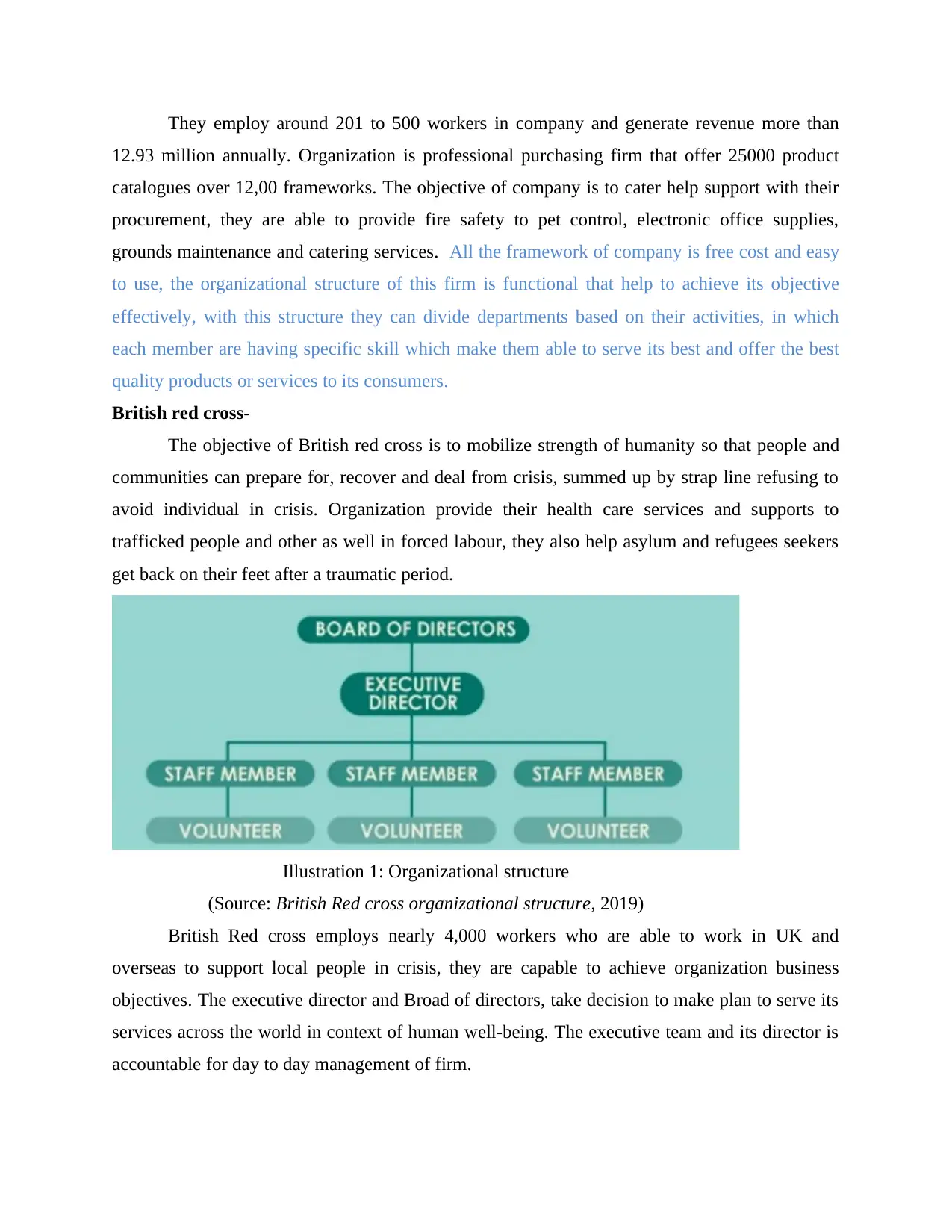
They employ around 201 to 500 workers in company and generate revenue more than
12.93 million annually. Organization is professional purchasing firm that offer 25000 product
catalogues over 12,00 frameworks. The objective of company is to cater help support with their
procurement, they are able to provide fire safety to pet control, electronic office supplies,
grounds maintenance and catering services. All the framework of company is free cost and easy
to use, the organizational structure of this firm is functional that help to achieve its objective
effectively, with this structure they can divide departments based on their activities, in which
each member are having specific skill which make them able to serve its best and offer the best
quality products or services to its consumers.
British red cross-
The objective of British red cross is to mobilize strength of humanity so that people and
communities can prepare for, recover and deal from crisis, summed up by strap line refusing to
avoid individual in crisis. Organization provide their health care services and supports to
trafficked people and other as well in forced labour, they also help asylum and refugees seekers
get back on their feet after a traumatic period.
Illustration 1: Organizational structure
(Source: British Red cross organizational structure, 2019)
British Red cross employs nearly 4,000 workers who are able to work in UK and
overseas to support local people in crisis, they are capable to achieve organization business
objectives. The executive director and Broad of directors, take decision to make plan to serve its
services across the world in context of human well-being. The executive team and its director is
accountable for day to day management of firm.
12.93 million annually. Organization is professional purchasing firm that offer 25000 product
catalogues over 12,00 frameworks. The objective of company is to cater help support with their
procurement, they are able to provide fire safety to pet control, electronic office supplies,
grounds maintenance and catering services. All the framework of company is free cost and easy
to use, the organizational structure of this firm is functional that help to achieve its objective
effectively, with this structure they can divide departments based on their activities, in which
each member are having specific skill which make them able to serve its best and offer the best
quality products or services to its consumers.
British red cross-
The objective of British red cross is to mobilize strength of humanity so that people and
communities can prepare for, recover and deal from crisis, summed up by strap line refusing to
avoid individual in crisis. Organization provide their health care services and supports to
trafficked people and other as well in forced labour, they also help asylum and refugees seekers
get back on their feet after a traumatic period.
Illustration 1: Organizational structure
(Source: British Red cross organizational structure, 2019)
British Red cross employs nearly 4,000 workers who are able to work in UK and
overseas to support local people in crisis, they are capable to achieve organization business
objectives. The executive director and Broad of directors, take decision to make plan to serve its
services across the world in context of human well-being. The executive team and its director is
accountable for day to day management of firm.
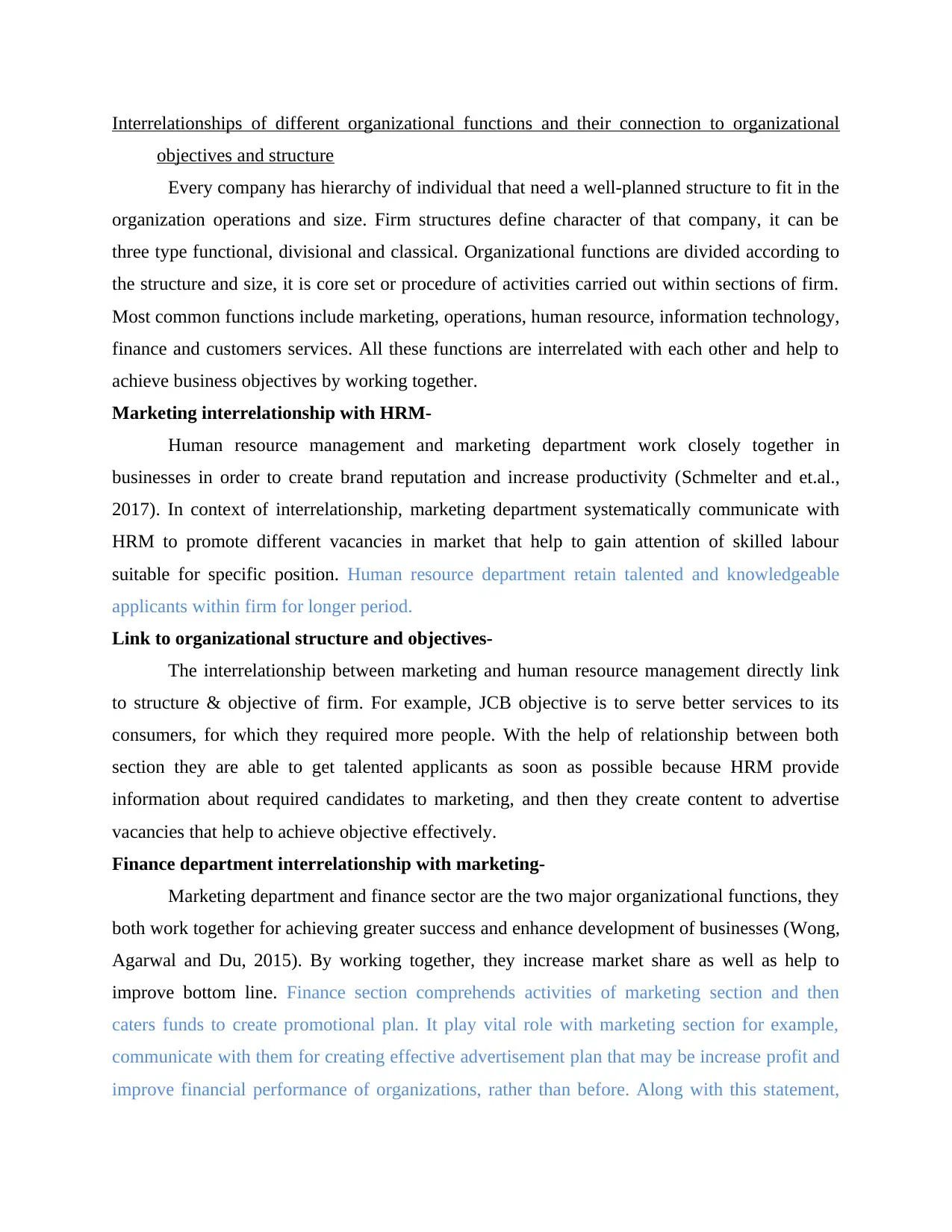
Interrelationships of different organizational functions and their connection to organizational
objectives and structure
Every company has hierarchy of individual that need a well-planned structure to fit in the
organization operations and size. Firm structures define character of that company, it can be
three type functional, divisional and classical. Organizational functions are divided according to
the structure and size, it is core set or procedure of activities carried out within sections of firm.
Most common functions include marketing, operations, human resource, information technology,
finance and customers services. All these functions are interrelated with each other and help to
achieve business objectives by working together.
Marketing interrelationship with HRM-
Human resource management and marketing department work closely together in
businesses in order to create brand reputation and increase productivity (Schmelter and et.al.,
2017). In context of interrelationship, marketing department systematically communicate with
HRM to promote different vacancies in market that help to gain attention of skilled labour
suitable for specific position. Human resource department retain talented and knowledgeable
applicants within firm for longer period.
Link to organizational structure and objectives-
The interrelationship between marketing and human resource management directly link
to structure & objective of firm. For example, JCB objective is to serve better services to its
consumers, for which they required more people. With the help of relationship between both
section they are able to get talented applicants as soon as possible because HRM provide
information about required candidates to marketing, and then they create content to advertise
vacancies that help to achieve objective effectively.
Finance department interrelationship with marketing-
Marketing department and finance sector are the two major organizational functions, they
both work together for achieving greater success and enhance development of businesses (Wong,
Agarwal and Du, 2015). By working together, they increase market share as well as help to
improve bottom line. Finance section comprehends activities of marketing section and then
caters funds to create promotional plan. It play vital role with marketing section for example,
communicate with them for creating effective advertisement plan that may be increase profit and
improve financial performance of organizations, rather than before. Along with this statement,
objectives and structure
Every company has hierarchy of individual that need a well-planned structure to fit in the
organization operations and size. Firm structures define character of that company, it can be
three type functional, divisional and classical. Organizational functions are divided according to
the structure and size, it is core set or procedure of activities carried out within sections of firm.
Most common functions include marketing, operations, human resource, information technology,
finance and customers services. All these functions are interrelated with each other and help to
achieve business objectives by working together.
Marketing interrelationship with HRM-
Human resource management and marketing department work closely together in
businesses in order to create brand reputation and increase productivity (Schmelter and et.al.,
2017). In context of interrelationship, marketing department systematically communicate with
HRM to promote different vacancies in market that help to gain attention of skilled labour
suitable for specific position. Human resource department retain talented and knowledgeable
applicants within firm for longer period.
Link to organizational structure and objectives-
The interrelationship between marketing and human resource management directly link
to structure & objective of firm. For example, JCB objective is to serve better services to its
consumers, for which they required more people. With the help of relationship between both
section they are able to get talented applicants as soon as possible because HRM provide
information about required candidates to marketing, and then they create content to advertise
vacancies that help to achieve objective effectively.
Finance department interrelationship with marketing-
Marketing department and finance sector are the two major organizational functions, they
both work together for achieving greater success and enhance development of businesses (Wong,
Agarwal and Du, 2015). By working together, they increase market share as well as help to
improve bottom line. Finance section comprehends activities of marketing section and then
caters funds to create promotional plan. It play vital role with marketing section for example,
communicate with them for creating effective advertisement plan that may be increase profit and
improve financial performance of organizations, rather than before. Along with this statement,
Secure Best Marks with AI Grader
Need help grading? Try our AI Grader for instant feedback on your assignments.
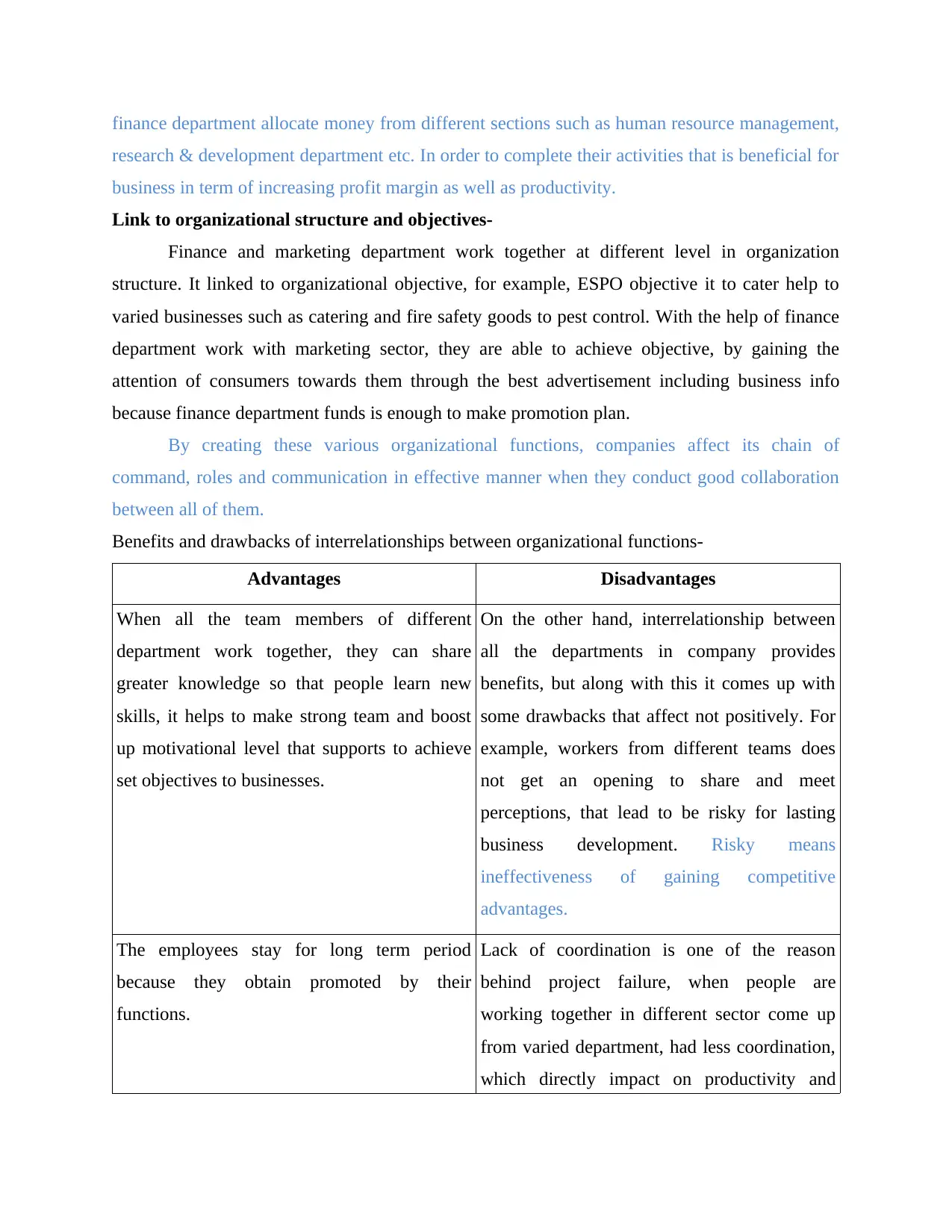
finance department allocate money from different sections such as human resource management,
research & development department etc. In order to complete their activities that is beneficial for
business in term of increasing profit margin as well as productivity.
Link to organizational structure and objectives-
Finance and marketing department work together at different level in organization
structure. It linked to organizational objective, for example, ESPO objective it to cater help to
varied businesses such as catering and fire safety goods to pest control. With the help of finance
department work with marketing sector, they are able to achieve objective, by gaining the
attention of consumers towards them through the best advertisement including business info
because finance department funds is enough to make promotion plan.
By creating these various organizational functions, companies affect its chain of
command, roles and communication in effective manner when they conduct good collaboration
between all of them.
Benefits and drawbacks of interrelationships between organizational functions-
Advantages Disadvantages
When all the team members of different
department work together, they can share
greater knowledge so that people learn new
skills, it helps to make strong team and boost
up motivational level that supports to achieve
set objectives to businesses.
On the other hand, interrelationship between
all the departments in company provides
benefits, but along with this it comes up with
some drawbacks that affect not positively. For
example, workers from different teams does
not get an opening to share and meet
perceptions, that lead to be risky for lasting
business development. Risky means
ineffectiveness of gaining competitive
advantages.
The employees stay for long term period
because they obtain promoted by their
functions.
Lack of coordination is one of the reason
behind project failure, when people are
working together in different sector come up
from varied department, had less coordination,
which directly impact on productivity and
research & development department etc. In order to complete their activities that is beneficial for
business in term of increasing profit margin as well as productivity.
Link to organizational structure and objectives-
Finance and marketing department work together at different level in organization
structure. It linked to organizational objective, for example, ESPO objective it to cater help to
varied businesses such as catering and fire safety goods to pest control. With the help of finance
department work with marketing sector, they are able to achieve objective, by gaining the
attention of consumers towards them through the best advertisement including business info
because finance department funds is enough to make promotion plan.
By creating these various organizational functions, companies affect its chain of
command, roles and communication in effective manner when they conduct good collaboration
between all of them.
Benefits and drawbacks of interrelationships between organizational functions-
Advantages Disadvantages
When all the team members of different
department work together, they can share
greater knowledge so that people learn new
skills, it helps to make strong team and boost
up motivational level that supports to achieve
set objectives to businesses.
On the other hand, interrelationship between
all the departments in company provides
benefits, but along with this it comes up with
some drawbacks that affect not positively. For
example, workers from different teams does
not get an opening to share and meet
perceptions, that lead to be risky for lasting
business development. Risky means
ineffectiveness of gaining competitive
advantages.
The employees stay for long term period
because they obtain promoted by their
functions.
Lack of coordination is one of the reason
behind project failure, when people are
working together in different sector come up
from varied department, had less coordination,
which directly impact on productivity and
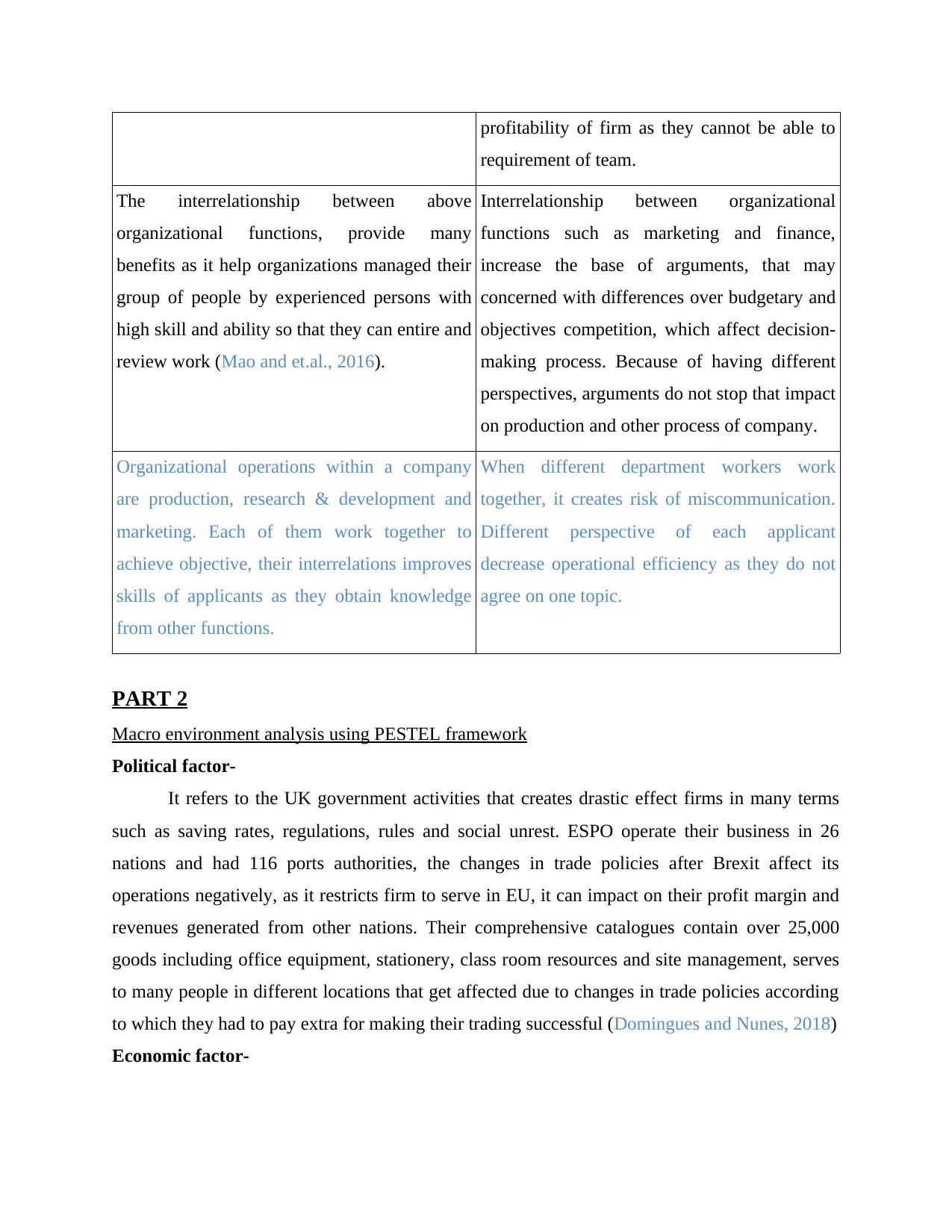
profitability of firm as they cannot be able to
requirement of team.
The interrelationship between above
organizational functions, provide many
benefits as it help organizations managed their
group of people by experienced persons with
high skill and ability so that they can entire and
review work (Mao and et.al., 2016).
Interrelationship between organizational
functions such as marketing and finance,
increase the base of arguments, that may
concerned with differences over budgetary and
objectives competition, which affect decision-
making process. Because of having different
perspectives, arguments do not stop that impact
on production and other process of company.
Organizational operations within a company
are production, research & development and
marketing. Each of them work together to
achieve objective, their interrelations improves
skills of applicants as they obtain knowledge
from other functions.
When different department workers work
together, it creates risk of miscommunication.
Different perspective of each applicant
decrease operational efficiency as they do not
agree on one topic.
PART 2
Macro environment analysis using PESTEL framework
Political factor-
It refers to the UK government activities that creates drastic effect firms in many terms
such as saving rates, regulations, rules and social unrest. ESPO operate their business in 26
nations and had 116 ports authorities, the changes in trade policies after Brexit affect its
operations negatively, as it restricts firm to serve in EU, it can impact on their profit margin and
revenues generated from other nations. Their comprehensive catalogues contain over 25,000
goods including office equipment, stationery, class room resources and site management, serves
to many people in different locations that get affected due to changes in trade policies according
to which they had to pay extra for making their trading successful (Domingues and Nunes, 2018)
Economic factor-
requirement of team.
The interrelationship between above
organizational functions, provide many
benefits as it help organizations managed their
group of people by experienced persons with
high skill and ability so that they can entire and
review work (Mao and et.al., 2016).
Interrelationship between organizational
functions such as marketing and finance,
increase the base of arguments, that may
concerned with differences over budgetary and
objectives competition, which affect decision-
making process. Because of having different
perspectives, arguments do not stop that impact
on production and other process of company.
Organizational operations within a company
are production, research & development and
marketing. Each of them work together to
achieve objective, their interrelations improves
skills of applicants as they obtain knowledge
from other functions.
When different department workers work
together, it creates risk of miscommunication.
Different perspective of each applicant
decrease operational efficiency as they do not
agree on one topic.
PART 2
Macro environment analysis using PESTEL framework
Political factor-
It refers to the UK government activities that creates drastic effect firms in many terms
such as saving rates, regulations, rules and social unrest. ESPO operate their business in 26
nations and had 116 ports authorities, the changes in trade policies after Brexit affect its
operations negatively, as it restricts firm to serve in EU, it can impact on their profit margin and
revenues generated from other nations. Their comprehensive catalogues contain over 25,000
goods including office equipment, stationery, class room resources and site management, serves
to many people in different locations that get affected due to changes in trade policies according
to which they had to pay extra for making their trading successful (Domingues and Nunes, 2018)
Economic factor-
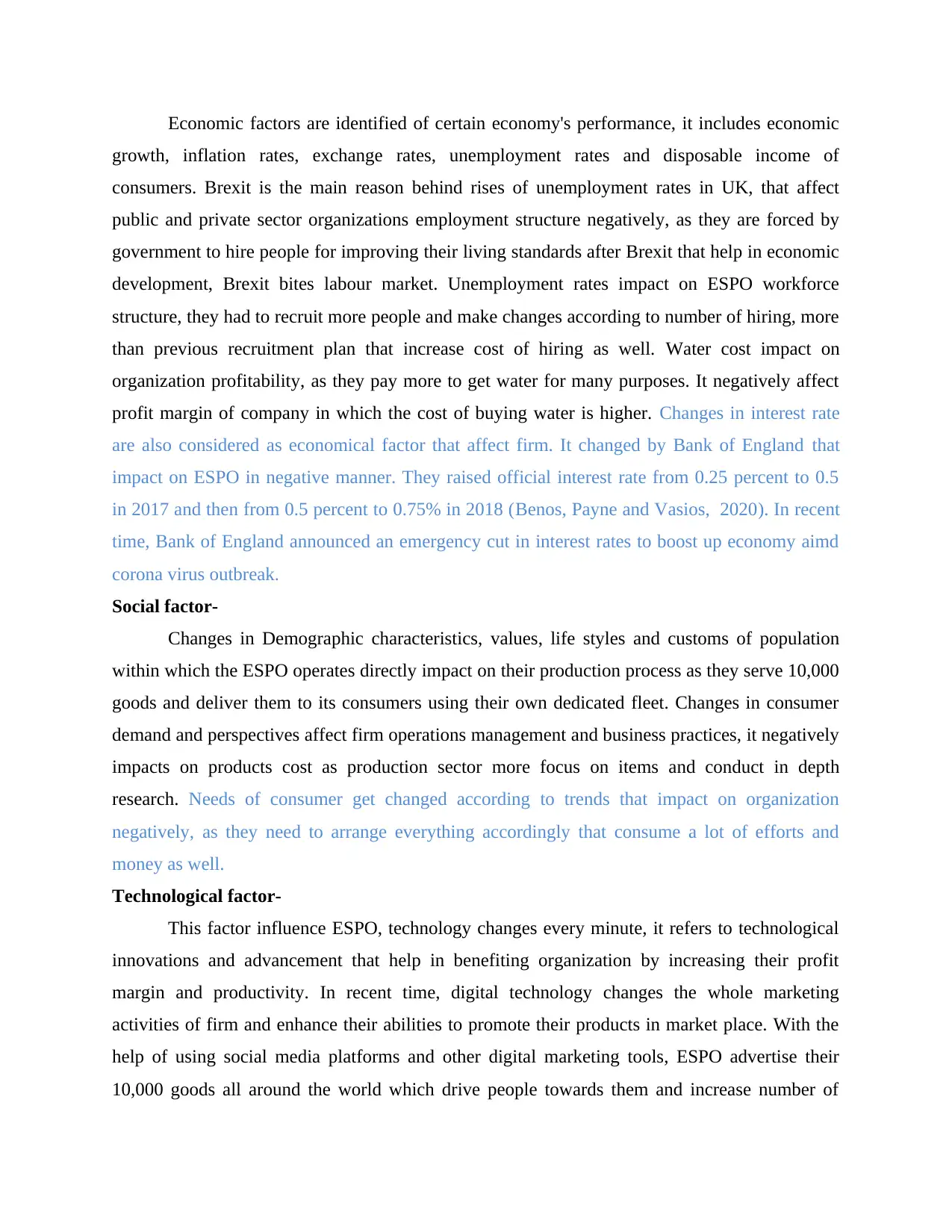
Economic factors are identified of certain economy's performance, it includes economic
growth, inflation rates, exchange rates, unemployment rates and disposable income of
consumers. Brexit is the main reason behind rises of unemployment rates in UK, that affect
public and private sector organizations employment structure negatively, as they are forced by
government to hire people for improving their living standards after Brexit that help in economic
development, Brexit bites labour market. Unemployment rates impact on ESPO workforce
structure, they had to recruit more people and make changes according to number of hiring, more
than previous recruitment plan that increase cost of hiring as well. Water cost impact on
organization profitability, as they pay more to get water for many purposes. It negatively affect
profit margin of company in which the cost of buying water is higher. Changes in interest rate
are also considered as economical factor that affect firm. It changed by Bank of England that
impact on ESPO in negative manner. They raised official interest rate from 0.25 percent to 0.5
in 2017 and then from 0.5 percent to 0.75% in 2018 (Benos, Payne and Vasios, 2020). In recent
time, Bank of England announced an emergency cut in interest rates to boost up economy aimd
corona virus outbreak.
Social factor-
Changes in Demographic characteristics, values, life styles and customs of population
within which the ESPO operates directly impact on their production process as they serve 10,000
goods and deliver them to its consumers using their own dedicated fleet. Changes in consumer
demand and perspectives affect firm operations management and business practices, it negatively
impacts on products cost as production sector more focus on items and conduct in depth
research. Needs of consumer get changed according to trends that impact on organization
negatively, as they need to arrange everything accordingly that consume a lot of efforts and
money as well.
Technological factor-
This factor influence ESPO, technology changes every minute, it refers to technological
innovations and advancement that help in benefiting organization by increasing their profit
margin and productivity. In recent time, digital technology changes the whole marketing
activities of firm and enhance their abilities to promote their products in market place. With the
help of using social media platforms and other digital marketing tools, ESPO advertise their
10,000 goods all around the world which drive people towards them and increase number of
growth, inflation rates, exchange rates, unemployment rates and disposable income of
consumers. Brexit is the main reason behind rises of unemployment rates in UK, that affect
public and private sector organizations employment structure negatively, as they are forced by
government to hire people for improving their living standards after Brexit that help in economic
development, Brexit bites labour market. Unemployment rates impact on ESPO workforce
structure, they had to recruit more people and make changes according to number of hiring, more
than previous recruitment plan that increase cost of hiring as well. Water cost impact on
organization profitability, as they pay more to get water for many purposes. It negatively affect
profit margin of company in which the cost of buying water is higher. Changes in interest rate
are also considered as economical factor that affect firm. It changed by Bank of England that
impact on ESPO in negative manner. They raised official interest rate from 0.25 percent to 0.5
in 2017 and then from 0.5 percent to 0.75% in 2018 (Benos, Payne and Vasios, 2020). In recent
time, Bank of England announced an emergency cut in interest rates to boost up economy aimd
corona virus outbreak.
Social factor-
Changes in Demographic characteristics, values, life styles and customs of population
within which the ESPO operates directly impact on their production process as they serve 10,000
goods and deliver them to its consumers using their own dedicated fleet. Changes in consumer
demand and perspectives affect firm operations management and business practices, it negatively
impacts on products cost as production sector more focus on items and conduct in depth
research. Needs of consumer get changed according to trends that impact on organization
negatively, as they need to arrange everything accordingly that consume a lot of efforts and
money as well.
Technological factor-
This factor influence ESPO, technology changes every minute, it refers to technological
innovations and advancement that help in benefiting organization by increasing their profit
margin and productivity. In recent time, digital technology changes the whole marketing
activities of firm and enhance their abilities to promote their products in market place. With the
help of using social media platforms and other digital marketing tools, ESPO advertise their
10,000 goods all around the world which drive people towards them and increase number of
Paraphrase This Document
Need a fresh take? Get an instant paraphrase of this document with our AI Paraphraser
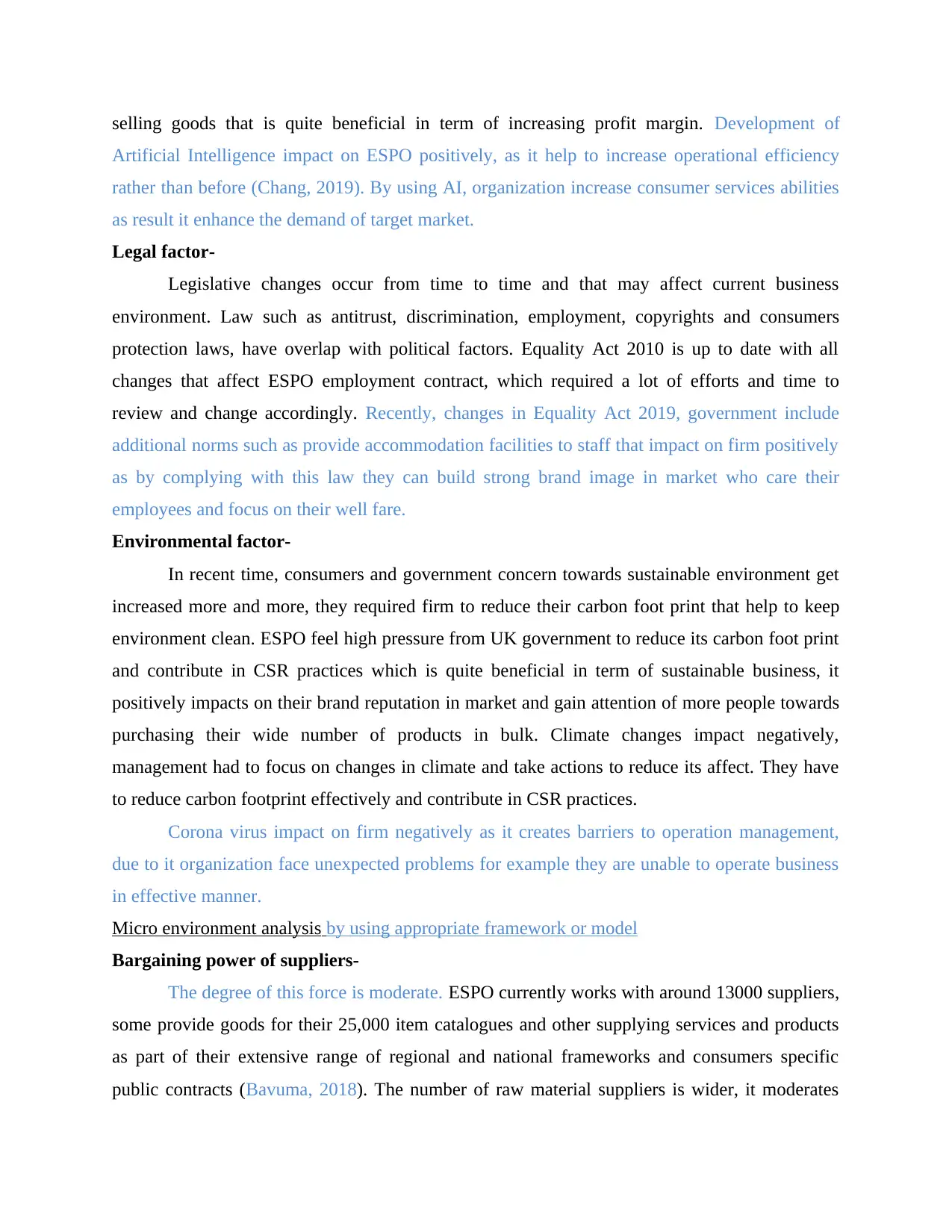
selling goods that is quite beneficial in term of increasing profit margin. Development of
Artificial Intelligence impact on ESPO positively, as it help to increase operational efficiency
rather than before (Chang, 2019). By using AI, organization increase consumer services abilities
as result it enhance the demand of target market.
Legal factor-
Legislative changes occur from time to time and that may affect current business
environment. Law such as antitrust, discrimination, employment, copyrights and consumers
protection laws, have overlap with political factors. Equality Act 2010 is up to date with all
changes that affect ESPO employment contract, which required a lot of efforts and time to
review and change accordingly. Recently, changes in Equality Act 2019, government include
additional norms such as provide accommodation facilities to staff that impact on firm positively
as by complying with this law they can build strong brand image in market who care their
employees and focus on their well fare.
Environmental factor-
In recent time, consumers and government concern towards sustainable environment get
increased more and more, they required firm to reduce their carbon foot print that help to keep
environment clean. ESPO feel high pressure from UK government to reduce its carbon foot print
and contribute in CSR practices which is quite beneficial in term of sustainable business, it
positively impacts on their brand reputation in market and gain attention of more people towards
purchasing their wide number of products in bulk. Climate changes impact negatively,
management had to focus on changes in climate and take actions to reduce its affect. They have
to reduce carbon footprint effectively and contribute in CSR practices.
Corona virus impact on firm negatively as it creates barriers to operation management,
due to it organization face unexpected problems for example they are unable to operate business
in effective manner.
Micro environment analysis by using appropriate framework or model
Bargaining power of suppliers-
The degree of this force is moderate. ESPO currently works with around 13000 suppliers,
some provide goods for their 25,000 item catalogues and other supplying services and products
as part of their extensive range of regional and national frameworks and consumers specific
public contracts (Bavuma, 2018). The number of raw material suppliers is wider, it moderates
Artificial Intelligence impact on ESPO positively, as it help to increase operational efficiency
rather than before (Chang, 2019). By using AI, organization increase consumer services abilities
as result it enhance the demand of target market.
Legal factor-
Legislative changes occur from time to time and that may affect current business
environment. Law such as antitrust, discrimination, employment, copyrights and consumers
protection laws, have overlap with political factors. Equality Act 2010 is up to date with all
changes that affect ESPO employment contract, which required a lot of efforts and time to
review and change accordingly. Recently, changes in Equality Act 2019, government include
additional norms such as provide accommodation facilities to staff that impact on firm positively
as by complying with this law they can build strong brand image in market who care their
employees and focus on their well fare.
Environmental factor-
In recent time, consumers and government concern towards sustainable environment get
increased more and more, they required firm to reduce their carbon foot print that help to keep
environment clean. ESPO feel high pressure from UK government to reduce its carbon foot print
and contribute in CSR practices which is quite beneficial in term of sustainable business, it
positively impacts on their brand reputation in market and gain attention of more people towards
purchasing their wide number of products in bulk. Climate changes impact negatively,
management had to focus on changes in climate and take actions to reduce its affect. They have
to reduce carbon footprint effectively and contribute in CSR practices.
Corona virus impact on firm negatively as it creates barriers to operation management,
due to it organization face unexpected problems for example they are unable to operate business
in effective manner.
Micro environment analysis by using appropriate framework or model
Bargaining power of suppliers-
The degree of this force is moderate. ESPO currently works with around 13000 suppliers,
some provide goods for their 25,000 item catalogues and other supplying services and products
as part of their extensive range of regional and national frameworks and consumers specific
public contracts (Bavuma, 2018). The number of raw material suppliers is wider, it moderates
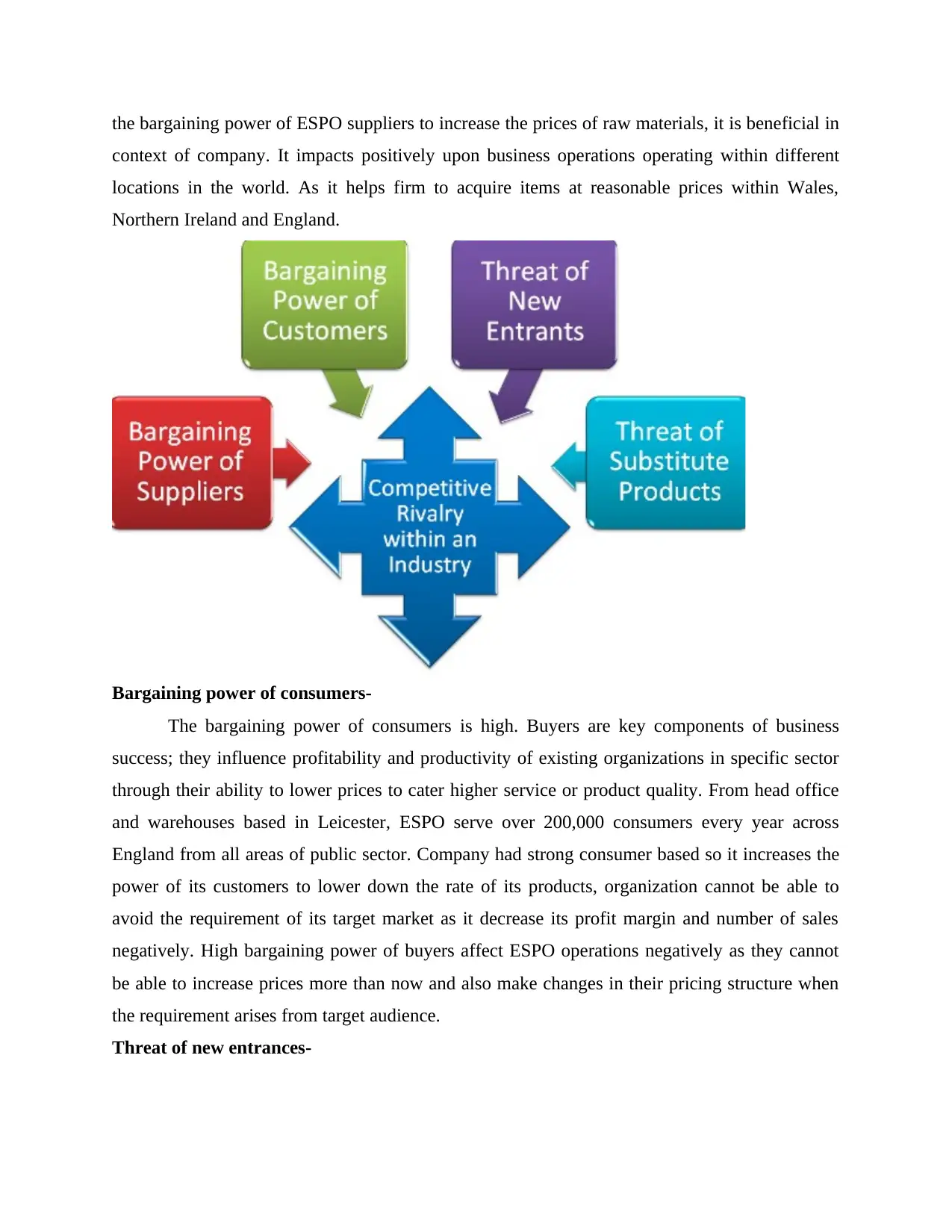
the bargaining power of ESPO suppliers to increase the prices of raw materials, it is beneficial in
context of company. It impacts positively upon business operations operating within different
locations in the world. As it helps firm to acquire items at reasonable prices within Wales,
Northern Ireland and England.
Bargaining power of consumers-
The bargaining power of consumers is high. Buyers are key components of business
success; they influence profitability and productivity of existing organizations in specific sector
through their ability to lower prices to cater higher service or product quality. From head office
and warehouses based in Leicester, ESPO serve over 200,000 consumers every year across
England from all areas of public sector. Company had strong consumer based so it increases the
power of its customers to lower down the rate of its products, organization cannot be able to
avoid the requirement of its target market as it decrease its profit margin and number of sales
negatively. High bargaining power of buyers affect ESPO operations negatively as they cannot
be able to increase prices more than now and also make changes in their pricing structure when
the requirement arises from target audience.
Threat of new entrances-
context of company. It impacts positively upon business operations operating within different
locations in the world. As it helps firm to acquire items at reasonable prices within Wales,
Northern Ireland and England.
Bargaining power of consumers-
The bargaining power of consumers is high. Buyers are key components of business
success; they influence profitability and productivity of existing organizations in specific sector
through their ability to lower prices to cater higher service or product quality. From head office
and warehouses based in Leicester, ESPO serve over 200,000 consumers every year across
England from all areas of public sector. Company had strong consumer based so it increases the
power of its customers to lower down the rate of its products, organization cannot be able to
avoid the requirement of its target market as it decrease its profit margin and number of sales
negatively. High bargaining power of buyers affect ESPO operations negatively as they cannot
be able to increase prices more than now and also make changes in their pricing structure when
the requirement arises from target audience.
Threat of new entrances-
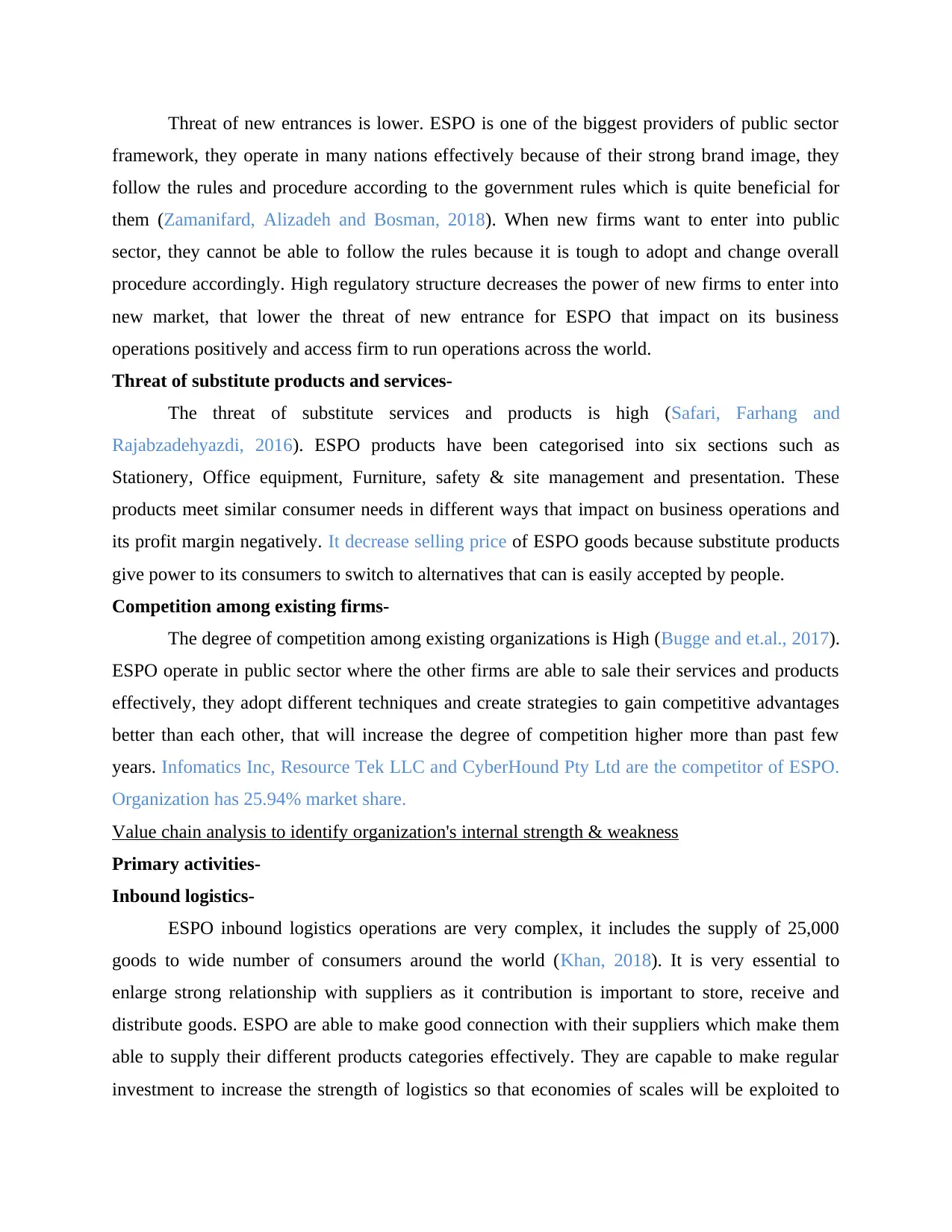
Threat of new entrances is lower. ESPO is one of the biggest providers of public sector
framework, they operate in many nations effectively because of their strong brand image, they
follow the rules and procedure according to the government rules which is quite beneficial for
them (Zamanifard, Alizadeh and Bosman, 2018). When new firms want to enter into public
sector, they cannot be able to follow the rules because it is tough to adopt and change overall
procedure accordingly. High regulatory structure decreases the power of new firms to enter into
new market, that lower the threat of new entrance for ESPO that impact on its business
operations positively and access firm to run operations across the world.
Threat of substitute products and services-
The threat of substitute services and products is high (Safari, Farhang and
Rajabzadehyazdi, 2016). ESPO products have been categorised into six sections such as
Stationery, Office equipment, Furniture, safety & site management and presentation. These
products meet similar consumer needs in different ways that impact on business operations and
its profit margin negatively. It decrease selling price of ESPO goods because substitute products
give power to its consumers to switch to alternatives that can is easily accepted by people.
Competition among existing firms-
The degree of competition among existing organizations is High (Bugge and et.al., 2017).
ESPO operate in public sector where the other firms are able to sale their services and products
effectively, they adopt different techniques and create strategies to gain competitive advantages
better than each other, that will increase the degree of competition higher more than past few
years. Infomatics Inc, Resource Tek LLC and CyberHound Pty Ltd are the competitor of ESPO.
Organization has 25.94% market share.
Value chain analysis to identify organization's internal strength & weakness
Primary activities-
Inbound logistics-
ESPO inbound logistics operations are very complex, it includes the supply of 25,000
goods to wide number of consumers around the world (Khan, 2018). It is very essential to
enlarge strong relationship with suppliers as it contribution is important to store, receive and
distribute goods. ESPO are able to make good connection with their suppliers which make them
able to supply their different products categories effectively. They are capable to make regular
investment to increase the strength of logistics so that economies of scales will be exploited to
framework, they operate in many nations effectively because of their strong brand image, they
follow the rules and procedure according to the government rules which is quite beneficial for
them (Zamanifard, Alizadeh and Bosman, 2018). When new firms want to enter into public
sector, they cannot be able to follow the rules because it is tough to adopt and change overall
procedure accordingly. High regulatory structure decreases the power of new firms to enter into
new market, that lower the threat of new entrance for ESPO that impact on its business
operations positively and access firm to run operations across the world.
Threat of substitute products and services-
The threat of substitute services and products is high (Safari, Farhang and
Rajabzadehyazdi, 2016). ESPO products have been categorised into six sections such as
Stationery, Office equipment, Furniture, safety & site management and presentation. These
products meet similar consumer needs in different ways that impact on business operations and
its profit margin negatively. It decrease selling price of ESPO goods because substitute products
give power to its consumers to switch to alternatives that can is easily accepted by people.
Competition among existing firms-
The degree of competition among existing organizations is High (Bugge and et.al., 2017).
ESPO operate in public sector where the other firms are able to sale their services and products
effectively, they adopt different techniques and create strategies to gain competitive advantages
better than each other, that will increase the degree of competition higher more than past few
years. Infomatics Inc, Resource Tek LLC and CyberHound Pty Ltd are the competitor of ESPO.
Organization has 25.94% market share.
Value chain analysis to identify organization's internal strength & weakness
Primary activities-
Inbound logistics-
ESPO inbound logistics operations are very complex, it includes the supply of 25,000
goods to wide number of consumers around the world (Khan, 2018). It is very essential to
enlarge strong relationship with suppliers as it contribution is important to store, receive and
distribute goods. ESPO are able to make good connection with their suppliers which make them
able to supply their different products categories effectively. They are capable to make regular
investment to increase the strength of logistics so that economies of scales will be exploited to
Secure Best Marks with AI Grader
Need help grading? Try our AI Grader for instant feedback on your assignments.
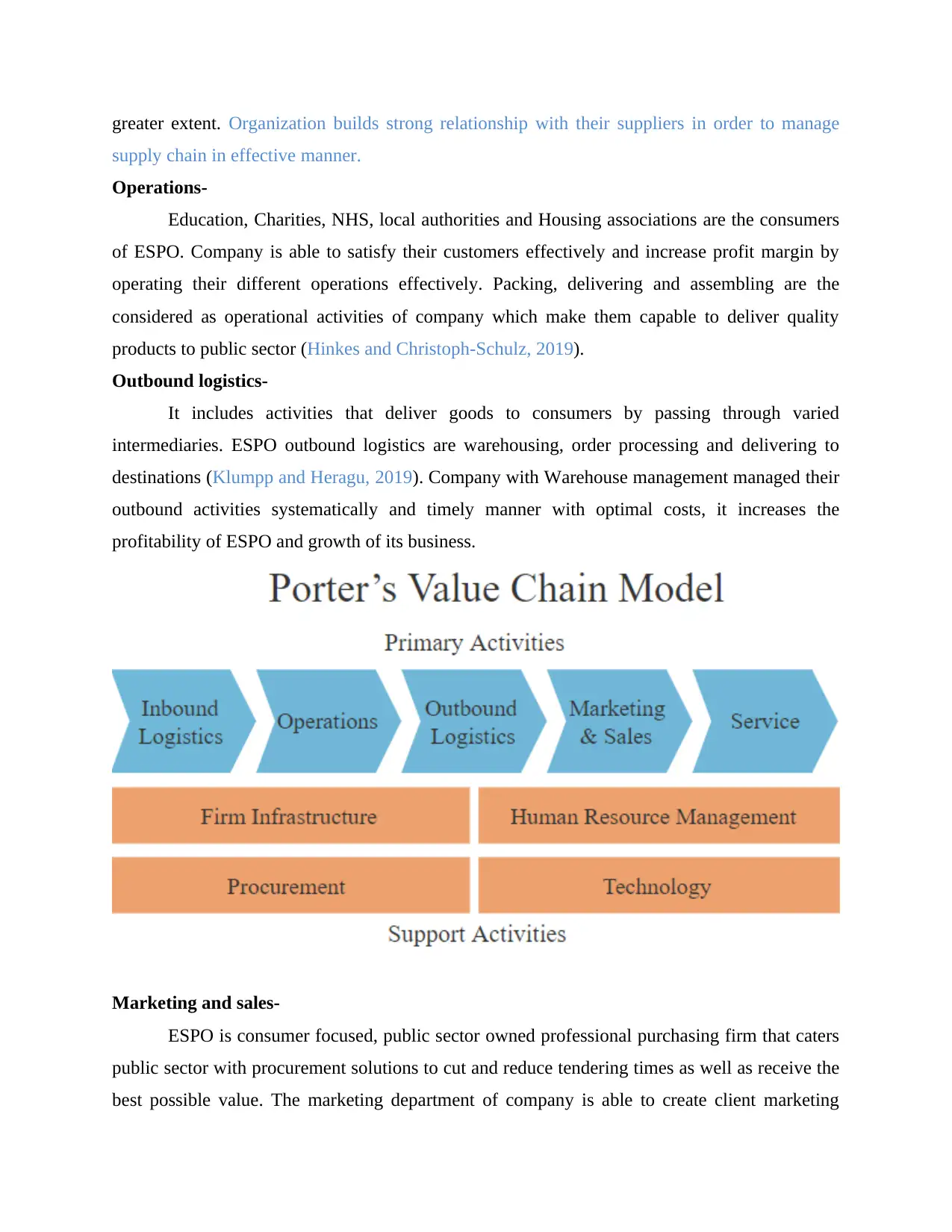
greater extent. Organization builds strong relationship with their suppliers in order to manage
supply chain in effective manner.
Operations-
Education, Charities, NHS, local authorities and Housing associations are the consumers
of ESPO. Company is able to satisfy their customers effectively and increase profit margin by
operating their different operations effectively. Packing, delivering and assembling are the
considered as operational activities of company which make them capable to deliver quality
products to public sector (Hinkes and Christoph-Schulz, 2019).
Outbound logistics-
It includes activities that deliver goods to consumers by passing through varied
intermediaries. ESPO outbound logistics are warehousing, order processing and delivering to
destinations (Klumpp and Heragu, 2019). Company with Warehouse management managed their
outbound activities systematically and timely manner with optimal costs, it increases the
profitability of ESPO and growth of its business.
Marketing and sales-
ESPO is consumer focused, public sector owned professional purchasing firm that caters
public sector with procurement solutions to cut and reduce tendering times as well as receive the
best possible value. The marketing department of company is able to create client marketing
supply chain in effective manner.
Operations-
Education, Charities, NHS, local authorities and Housing associations are the consumers
of ESPO. Company is able to satisfy their customers effectively and increase profit margin by
operating their different operations effectively. Packing, delivering and assembling are the
considered as operational activities of company which make them capable to deliver quality
products to public sector (Hinkes and Christoph-Schulz, 2019).
Outbound logistics-
It includes activities that deliver goods to consumers by passing through varied
intermediaries. ESPO outbound logistics are warehousing, order processing and delivering to
destinations (Klumpp and Heragu, 2019). Company with Warehouse management managed their
outbound activities systematically and timely manner with optimal costs, it increases the
profitability of ESPO and growth of its business.
Marketing and sales-
ESPO is consumer focused, public sector owned professional purchasing firm that caters
public sector with procurement solutions to cut and reduce tendering times as well as receive the
best possible value. The marketing department of company is able to create client marketing
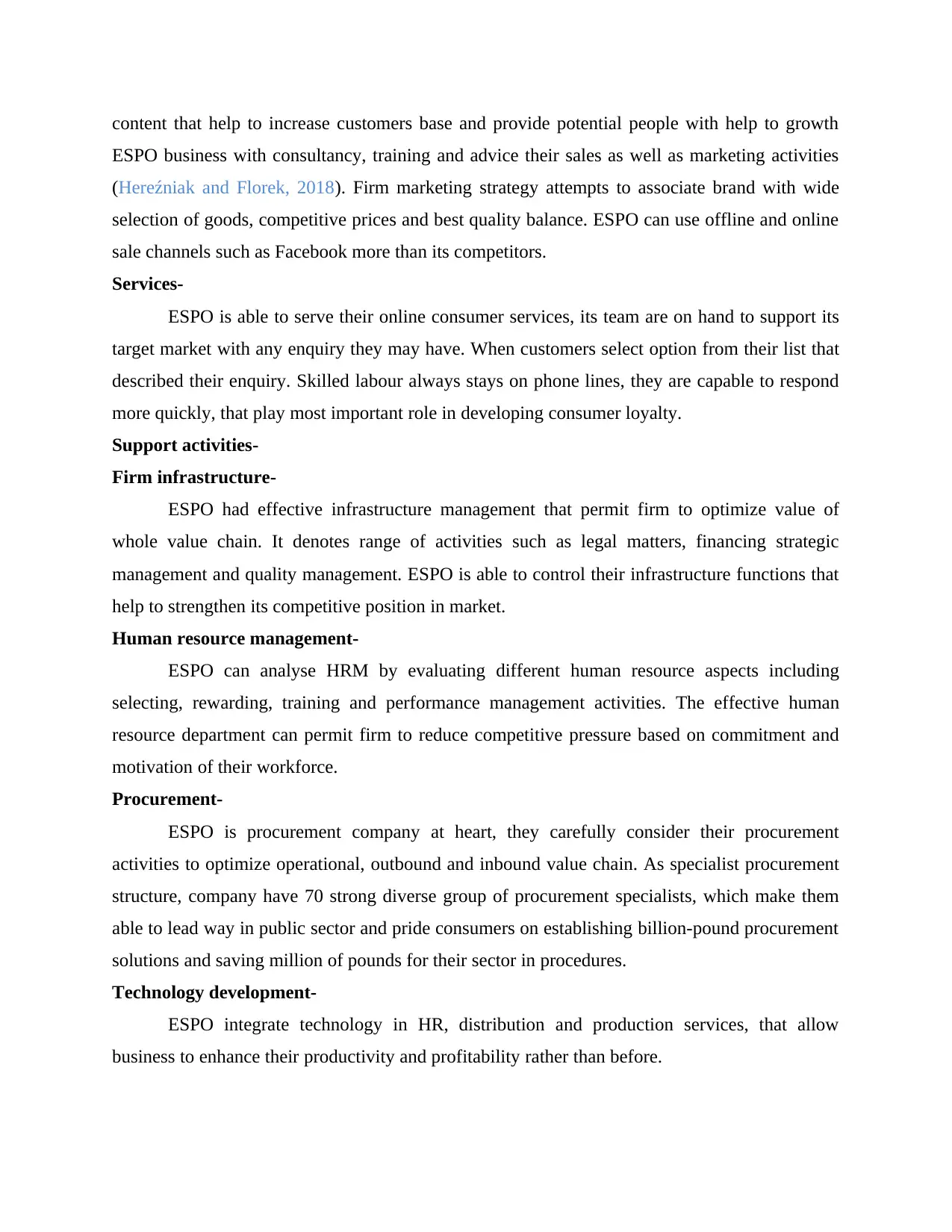
content that help to increase customers base and provide potential people with help to growth
ESPO business with consultancy, training and advice their sales as well as marketing activities
(Hereźniak and Florek, 2018). Firm marketing strategy attempts to associate brand with wide
selection of goods, competitive prices and best quality balance. ESPO can use offline and online
sale channels such as Facebook more than its competitors.
Services-
ESPO is able to serve their online consumer services, its team are on hand to support its
target market with any enquiry they may have. When customers select option from their list that
described their enquiry. Skilled labour always stays on phone lines, they are capable to respond
more quickly, that play most important role in developing consumer loyalty.
Support activities-
Firm infrastructure-
ESPO had effective infrastructure management that permit firm to optimize value of
whole value chain. It denotes range of activities such as legal matters, financing strategic
management and quality management. ESPO is able to control their infrastructure functions that
help to strengthen its competitive position in market.
Human resource management-
ESPO can analyse HRM by evaluating different human resource aspects including
selecting, rewarding, training and performance management activities. The effective human
resource department can permit firm to reduce competitive pressure based on commitment and
motivation of their workforce.
Procurement-
ESPO is procurement company at heart, they carefully consider their procurement
activities to optimize operational, outbound and inbound value chain. As specialist procurement
structure, company have 70 strong diverse group of procurement specialists, which make them
able to lead way in public sector and pride consumers on establishing billion-pound procurement
solutions and saving million of pounds for their sector in procedures.
Technology development-
ESPO integrate technology in HR, distribution and production services, that allow
business to enhance their productivity and profitability rather than before.
ESPO business with consultancy, training and advice their sales as well as marketing activities
(Hereźniak and Florek, 2018). Firm marketing strategy attempts to associate brand with wide
selection of goods, competitive prices and best quality balance. ESPO can use offline and online
sale channels such as Facebook more than its competitors.
Services-
ESPO is able to serve their online consumer services, its team are on hand to support its
target market with any enquiry they may have. When customers select option from their list that
described their enquiry. Skilled labour always stays on phone lines, they are capable to respond
more quickly, that play most important role in developing consumer loyalty.
Support activities-
Firm infrastructure-
ESPO had effective infrastructure management that permit firm to optimize value of
whole value chain. It denotes range of activities such as legal matters, financing strategic
management and quality management. ESPO is able to control their infrastructure functions that
help to strengthen its competitive position in market.
Human resource management-
ESPO can analyse HRM by evaluating different human resource aspects including
selecting, rewarding, training and performance management activities. The effective human
resource department can permit firm to reduce competitive pressure based on commitment and
motivation of their workforce.
Procurement-
ESPO is procurement company at heart, they carefully consider their procurement
activities to optimize operational, outbound and inbound value chain. As specialist procurement
structure, company have 70 strong diverse group of procurement specialists, which make them
able to lead way in public sector and pride consumers on establishing billion-pound procurement
solutions and saving million of pounds for their sector in procedures.
Technology development-
ESPO integrate technology in HR, distribution and production services, that allow
business to enhance their productivity and profitability rather than before.

SWOT analysis
Strength-
ESPO is one of the largest professional purchasing firm in UK, they are able to
committed to offering best value to its consumers, local communities and suppliers. With the
help of skilled employee and procurement specialist, firm is capable to deliver 25,000 products
with more over 300 dedicated members of employees striving to deliver the very best items to
consumers.
Weakness-
Lack of management in some areas of ESPO affect its working structure and productivity
of firm as well as efficiency of operations.
Opportunity-
Technological advancement is the best opportunity for ESPO, which they can use to
enhance their online presence more than other firms in public sector.
Threat-
High competition among existing firms possess threat for ESPO and affect its consumer
base when competitors provide affordable products to people more than it.
Strength and weakness interrelated with external micro and macro factors, that influence
strategic business decision making
From above analysis it has been justified strength and weakness interrelated with external
macro & micro factors that affect strategic business decision making process. With skilled
labour, ESPO is capable to implement latest technologies within their business and conduct
research to identify consumer perspective change accordant to trends. It affects strategic business
decision making procedure of ESPO, its Human resource management trained their existing
workforce to enhance productivity. To reduce, threat of high competition organization take
decision to promote their products and improve its quality rather than before by focusing on
production activities.
CONCLUSION
It has been summarized, that private, public and voluntary firm operating with different
organizational structure. The interrelationship between marketing and Human resource
management and Finance with Marketing help to achieve business objective and generate brand
awareness within market place effectively. From above analysis, it has been concluded that
Strength-
ESPO is one of the largest professional purchasing firm in UK, they are able to
committed to offering best value to its consumers, local communities and suppliers. With the
help of skilled employee and procurement specialist, firm is capable to deliver 25,000 products
with more over 300 dedicated members of employees striving to deliver the very best items to
consumers.
Weakness-
Lack of management in some areas of ESPO affect its working structure and productivity
of firm as well as efficiency of operations.
Opportunity-
Technological advancement is the best opportunity for ESPO, which they can use to
enhance their online presence more than other firms in public sector.
Threat-
High competition among existing firms possess threat for ESPO and affect its consumer
base when competitors provide affordable products to people more than it.
Strength and weakness interrelated with external micro and macro factors, that influence
strategic business decision making
From above analysis it has been justified strength and weakness interrelated with external
macro & micro factors that affect strategic business decision making process. With skilled
labour, ESPO is capable to implement latest technologies within their business and conduct
research to identify consumer perspective change accordant to trends. It affects strategic business
decision making procedure of ESPO, its Human resource management trained their existing
workforce to enhance productivity. To reduce, threat of high competition organization take
decision to promote their products and improve its quality rather than before by focusing on
production activities.
CONCLUSION
It has been summarized, that private, public and voluntary firm operating with different
organizational structure. The interrelationship between marketing and Human resource
management and Finance with Marketing help to achieve business objective and generate brand
awareness within market place effectively. From above analysis, it has been concluded that
Paraphrase This Document
Need a fresh take? Get an instant paraphrase of this document with our AI Paraphraser

ESPO operate and manager their business operations with knowledgeable worker. By
considering all its management areas they effectively manage each activity in outbound and
inbound logistics. Furthermore, by analysing above study, it has been summarized that
organization effectively adopt artificial intelligence technology that enhance their productivity
level rather than before and increase profit margin.
considering all its management areas they effectively manage each activity in outbound and
inbound logistics. Furthermore, by analysing above study, it has been summarized that
organization effectively adopt artificial intelligence technology that enhance their productivity
level rather than before and increase profit margin.
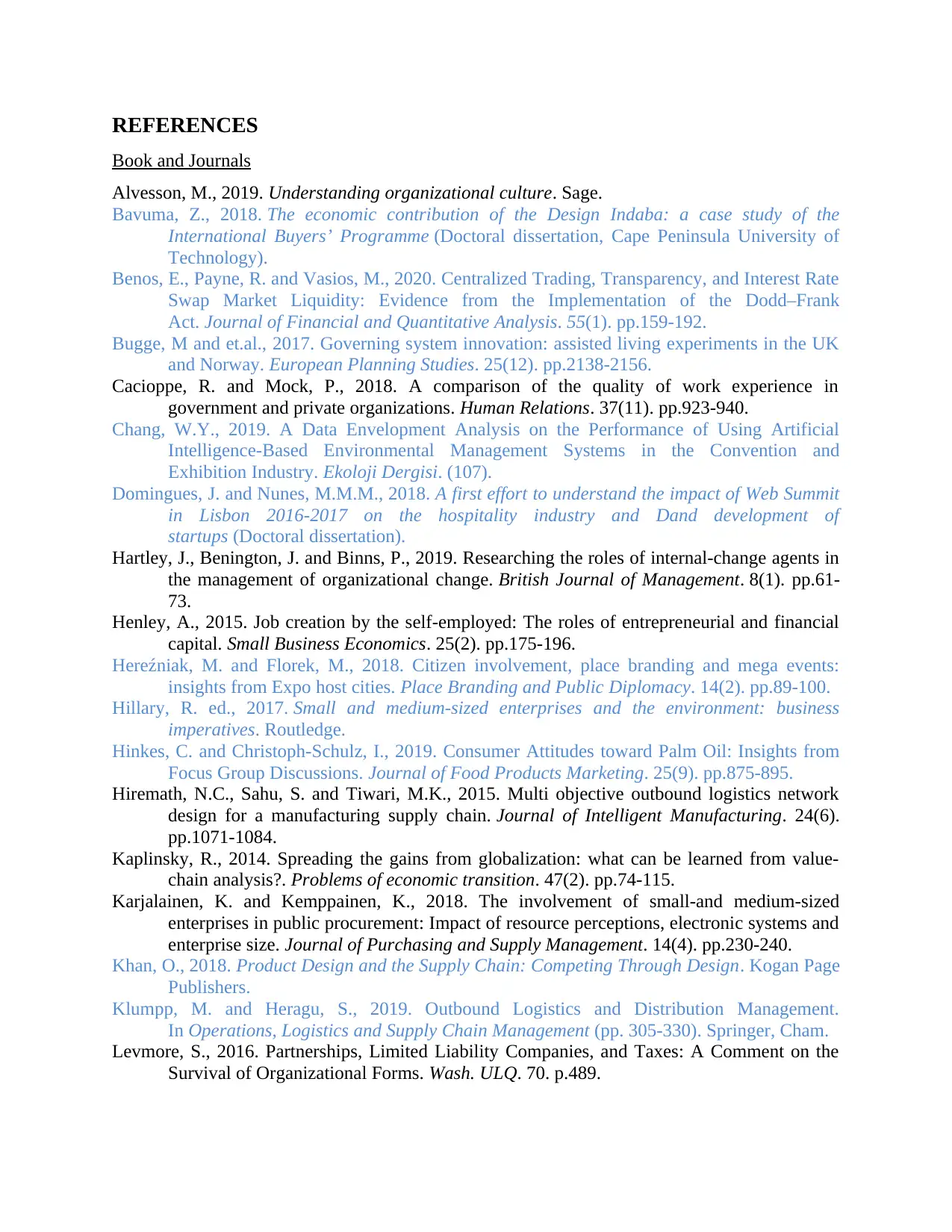
REFERENCES
Book and Journals
Alvesson, M., 2019. Understanding organizational culture. Sage.
Bavuma, Z., 2018. The economic contribution of the Design Indaba: a case study of the
International Buyers’ Programme (Doctoral dissertation, Cape Peninsula University of
Technology).
Benos, E., Payne, R. and Vasios, M., 2020. Centralized Trading, Transparency, and Interest Rate
Swap Market Liquidity: Evidence from the Implementation of the Dodd–Frank
Act. Journal of Financial and Quantitative Analysis. 55(1). pp.159-192.
Bugge, M and et.al., 2017. Governing system innovation: assisted living experiments in the UK
and Norway. European Planning Studies. 25(12). pp.2138-2156.
Cacioppe, R. and Mock, P., 2018. A comparison of the quality of work experience in
government and private organizations. Human Relations. 37(11). pp.923-940.
Chang, W.Y., 2019. A Data Envelopment Analysis on the Performance of Using Artificial
Intelligence-Based Environmental Management Systems in the Convention and
Exhibition Industry. Ekoloji Dergisi. (107).
Domingues, J. and Nunes, M.M.M., 2018. A first effort to understand the impact of Web Summit
in Lisbon 2016-2017 on the hospitality industry and Dand development of
startups (Doctoral dissertation).
Hartley, J., Benington, J. and Binns, P., 2019. Researching the roles of internal‐change agents in
the management of organizational change. British Journal of Management. 8(1). pp.61-
73.
Henley, A., 2015. Job creation by the self-employed: The roles of entrepreneurial and financial
capital. Small Business Economics. 25(2). pp.175-196.
Hereźniak, M. and Florek, M., 2018. Citizen involvement, place branding and mega events:
insights from Expo host cities. Place Branding and Public Diplomacy. 14(2). pp.89-100.
Hillary, R. ed., 2017. Small and medium-sized enterprises and the environment: business
imperatives. Routledge.
Hinkes, C. and Christoph-Schulz, I., 2019. Consumer Attitudes toward Palm Oil: Insights from
Focus Group Discussions. Journal of Food Products Marketing. 25(9). pp.875-895.
Hiremath, N.C., Sahu, S. and Tiwari, M.K., 2015. Multi objective outbound logistics network
design for a manufacturing supply chain. Journal of Intelligent Manufacturing. 24(6).
pp.1071-1084.
Kaplinsky, R., 2014. Spreading the gains from globalization: what can be learned from value-
chain analysis?. Problems of economic transition. 47(2). pp.74-115.
Karjalainen, K. and Kemppainen, K., 2018. The involvement of small-and medium-sized
enterprises in public procurement: Impact of resource perceptions, electronic systems and
enterprise size. Journal of Purchasing and Supply Management. 14(4). pp.230-240.
Khan, O., 2018. Product Design and the Supply Chain: Competing Through Design. Kogan Page
Publishers.
Klumpp, M. and Heragu, S., 2019. Outbound Logistics and Distribution Management.
In Operations, Logistics and Supply Chain Management (pp. 305-330). Springer, Cham.
Levmore, S., 2016. Partnerships, Limited Liability Companies, and Taxes: A Comment on the
Survival of Organizational Forms. Wash. ULQ. 70. p.489.
Book and Journals
Alvesson, M., 2019. Understanding organizational culture. Sage.
Bavuma, Z., 2018. The economic contribution of the Design Indaba: a case study of the
International Buyers’ Programme (Doctoral dissertation, Cape Peninsula University of
Technology).
Benos, E., Payne, R. and Vasios, M., 2020. Centralized Trading, Transparency, and Interest Rate
Swap Market Liquidity: Evidence from the Implementation of the Dodd–Frank
Act. Journal of Financial and Quantitative Analysis. 55(1). pp.159-192.
Bugge, M and et.al., 2017. Governing system innovation: assisted living experiments in the UK
and Norway. European Planning Studies. 25(12). pp.2138-2156.
Cacioppe, R. and Mock, P., 2018. A comparison of the quality of work experience in
government and private organizations. Human Relations. 37(11). pp.923-940.
Chang, W.Y., 2019. A Data Envelopment Analysis on the Performance of Using Artificial
Intelligence-Based Environmental Management Systems in the Convention and
Exhibition Industry. Ekoloji Dergisi. (107).
Domingues, J. and Nunes, M.M.M., 2018. A first effort to understand the impact of Web Summit
in Lisbon 2016-2017 on the hospitality industry and Dand development of
startups (Doctoral dissertation).
Hartley, J., Benington, J. and Binns, P., 2019. Researching the roles of internal‐change agents in
the management of organizational change. British Journal of Management. 8(1). pp.61-
73.
Henley, A., 2015. Job creation by the self-employed: The roles of entrepreneurial and financial
capital. Small Business Economics. 25(2). pp.175-196.
Hereźniak, M. and Florek, M., 2018. Citizen involvement, place branding and mega events:
insights from Expo host cities. Place Branding and Public Diplomacy. 14(2). pp.89-100.
Hillary, R. ed., 2017. Small and medium-sized enterprises and the environment: business
imperatives. Routledge.
Hinkes, C. and Christoph-Schulz, I., 2019. Consumer Attitudes toward Palm Oil: Insights from
Focus Group Discussions. Journal of Food Products Marketing. 25(9). pp.875-895.
Hiremath, N.C., Sahu, S. and Tiwari, M.K., 2015. Multi objective outbound logistics network
design for a manufacturing supply chain. Journal of Intelligent Manufacturing. 24(6).
pp.1071-1084.
Kaplinsky, R., 2014. Spreading the gains from globalization: what can be learned from value-
chain analysis?. Problems of economic transition. 47(2). pp.74-115.
Karjalainen, K. and Kemppainen, K., 2018. The involvement of small-and medium-sized
enterprises in public procurement: Impact of resource perceptions, electronic systems and
enterprise size. Journal of Purchasing and Supply Management. 14(4). pp.230-240.
Khan, O., 2018. Product Design and the Supply Chain: Competing Through Design. Kogan Page
Publishers.
Klumpp, M. and Heragu, S., 2019. Outbound Logistics and Distribution Management.
In Operations, Logistics and Supply Chain Management (pp. 305-330). Springer, Cham.
Levmore, S., 2016. Partnerships, Limited Liability Companies, and Taxes: A Comment on the
Survival of Organizational Forms. Wash. ULQ. 70. p.489.

Liljeblom, E., Maury, B. and Hörhammer, A., 2019. Complex state ownership, competition, and
firm performance–Russian evidence. International Journal of Emerging Markets.
Mao, H and et.al., 2016. Information technology resource, knowledge management capability,
and competitive advantage: The moderating role of resource commitment. International
Journal of Information Management. 36(6). pp.1062-1074.
Pearson, T.R and et.al., 2016. Micro vs small enterprises: a profile of human resource personnel,
practices and support systems. Journal of Management Research. 6(2). pp.102-112.
Safari, N., Farhang, M. and Rajabzadehyazdi, E., 2016. The study on the competitive status of
construction companies based on Michael Porter's five competitive forces (Case study:
Armeno Project Development and Management Company). European Online Journal of
Natural and Social Sciences: Proceedings. 5(3 (s)). pp.pp-72.
Schmelter, R and et.al., 2017. Boosting corporate entrepreneurship through HRM practices:
Evidence from German SMEs. Human Resource Management. 49(4). pp.715-741.
Wettenhall, R., 2020. Exploring types of public sector organizations: past exercises and current
issues. Public Organization Review. 3(3). pp.219-245.
Wong, W.K., Agarwal, A. and Du, J., 2015. Financial integration for India stock market, a
fractional cointegration approach. National University of Singapore Working Paper No.
WP0501.
Zamanifard, H., Alizadeh, T. and Bosman, C., 2018. Towards a framework of public space
governance. Cities. 78. pp.155-165.
Online
British Red cross organizational structure. 2019. [Online]. Available through:
<https://www.redcross.org.uk/about-us/how-we-are-run#:~:text=See%20our%20strategy
%2C%20structure%20and,our%20core%20ethos%20and%20values. >
JCB Organizational Structure. 2019. [Online]. Available through:<
http://www.jcbeurope.eu/about/company/organisation.html>
firm performance–Russian evidence. International Journal of Emerging Markets.
Mao, H and et.al., 2016. Information technology resource, knowledge management capability,
and competitive advantage: The moderating role of resource commitment. International
Journal of Information Management. 36(6). pp.1062-1074.
Pearson, T.R and et.al., 2016. Micro vs small enterprises: a profile of human resource personnel,
practices and support systems. Journal of Management Research. 6(2). pp.102-112.
Safari, N., Farhang, M. and Rajabzadehyazdi, E., 2016. The study on the competitive status of
construction companies based on Michael Porter's five competitive forces (Case study:
Armeno Project Development and Management Company). European Online Journal of
Natural and Social Sciences: Proceedings. 5(3 (s)). pp.pp-72.
Schmelter, R and et.al., 2017. Boosting corporate entrepreneurship through HRM practices:
Evidence from German SMEs. Human Resource Management. 49(4). pp.715-741.
Wettenhall, R., 2020. Exploring types of public sector organizations: past exercises and current
issues. Public Organization Review. 3(3). pp.219-245.
Wong, W.K., Agarwal, A. and Du, J., 2015. Financial integration for India stock market, a
fractional cointegration approach. National University of Singapore Working Paper No.
WP0501.
Zamanifard, H., Alizadeh, T. and Bosman, C., 2018. Towards a framework of public space
governance. Cities. 78. pp.155-165.
Online
British Red cross organizational structure. 2019. [Online]. Available through:
<https://www.redcross.org.uk/about-us/how-we-are-run#:~:text=See%20our%20strategy
%2C%20structure%20and,our%20core%20ethos%20and%20values. >
JCB Organizational Structure. 2019. [Online]. Available through:<
http://www.jcbeurope.eu/about/company/organisation.html>
Secure Best Marks with AI Grader
Need help grading? Try our AI Grader for instant feedback on your assignments.

1 out of 23
Related Documents
Your All-in-One AI-Powered Toolkit for Academic Success.
+13062052269
info@desklib.com
Available 24*7 on WhatsApp / Email
![[object Object]](/_next/static/media/star-bottom.7253800d.svg)
Unlock your academic potential
© 2024 | Zucol Services PVT LTD | All rights reserved.




